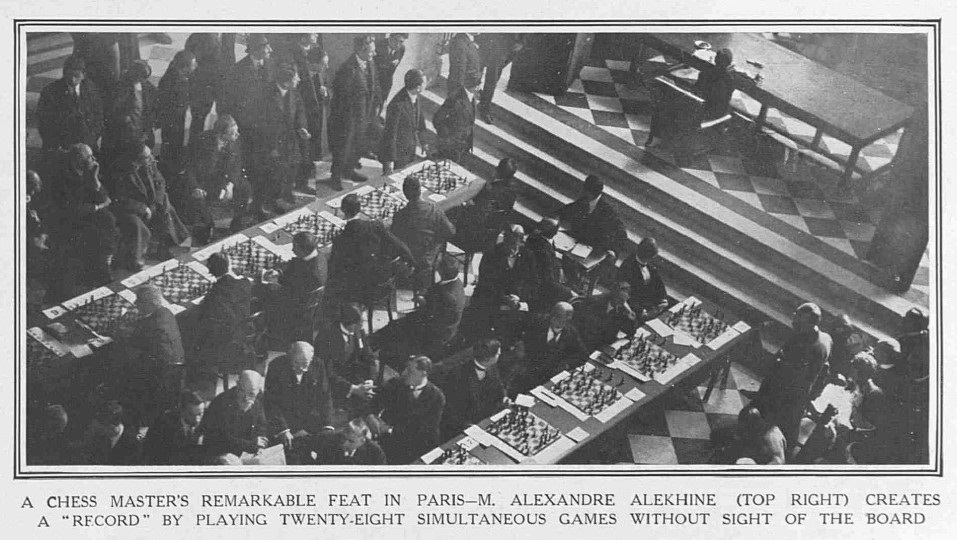
The Sphere, 7 February 1925, page 147
Edward Winter

The Sphere, 7 February 1925, page 147
Section One of this article is an assessment of Blindfold Chess by Eliot Hearst and John Knott (Jefferson, 2009) which we contributed to ChessBase in 2009. Section Two lists alphabetically various blindfold specialists whose exploits have been covered in Chess Notes over the past 40 years, with particular emphasis on lesser-known material. Section Three comprises a miscellany of other items related to blindfold chess.
**
Just occasionally a book turns up which is likely to be of widespread interest throughout all parts of the chess world. Blindfold Chess by E. Hearst and J. Knott (McFarland, 2009), hot off the press, is by far the most detailed study ever made of this fascinating subject. We take an early dip into it.
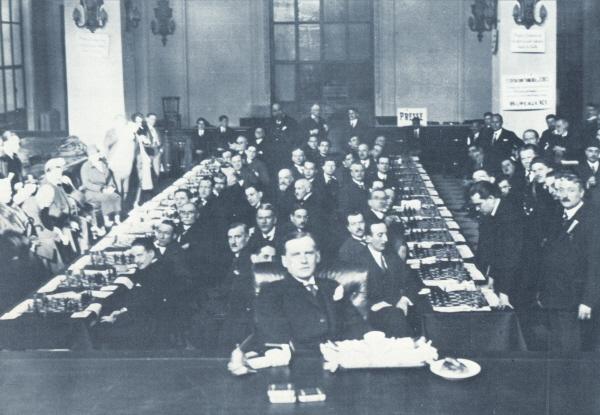
Alexander Alekhine
Blindfold Chess (subtitle: ‘History, Psychology, Techniques, Champions, World Records, and Important Games’) by Eliot Hearst and John Knott (McFarland & Company, Inc., Jefferson, 2009) is a beautiful 445-page hardback with over 60 photographs. From the very start (page 1) the co-authors encourage the reader not to regard blindfold chess as an elite activity: ‘Almost anyone who is a fairly strong amateur can easily learn to play at least one or two games without sight of the board’. The next page explains their project:
‘... we have been collecting historical data; selecting particularly interesting games out of the many hundreds of blindfold games available; investigating the validity of claims for world record-setting performances in terms of the number of opponents played simultaneously and other criteria; trying to master the relevant psychological literature on chessplayers’ memory, imagery and expertise, so as to relate basic mental processes to what topnotch blindfold players actually say about how they achieve their often spectacular results; seeking substantiation or disproof of our joint belief that development of skill at blindfold play is one important route to chess improvement; and pondering the possible application of similar training methods for other human endeavors that also entail the memory and planning of sequences of responses, especially those involving visual-spatial tasks or capacities.’
Also from the outset (page 10) Hearst and Knott announce that Alekhine ‘will turn out to be our clear choice for the best blindfold player of all time’, and the same page argues that Najdorf ‘is the rightful holder of the world simultaneous blindfold record at 45 games, played in 1947’.
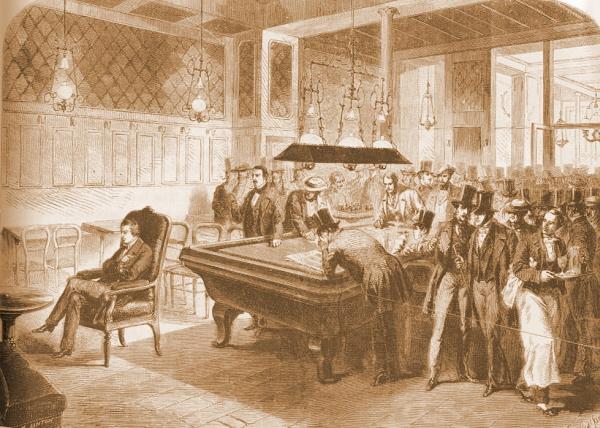
Paul Morphy
The book is structured in three parts.
Part I (pages 15-147) has sections entitled Even Before Philidor, François-André Philidor, Between Philidor and the Late 1800s, The First Part of the Twentieth Century, The Last Fifty Years, Women and Blindfold Chess, and Major Recent Tournaments and Matches. The players featured include Philidor, Paulsen, Morphy, Blackburne, Zukertort, Pillsbury, Ostrogsky, Réti, Breyer, Alekhine, Koltanowski, Najdorf, Flesch and Fine and, from more recent times, Hort, Kasparov and a number of today’s leading players. Those unfamiliar with the mysterious Vladimir Ostrogsky will welcome the section devoted to him (pages 59-62) and the inclusion later in the book of all 23 games of his display in Moscow on 15 February 1904, at which he set a new world record. Tony Miles is mentioned on page 122 as ‘an anomaly in the history of simultaneous blindfold chess’ because he gave only one display of significance (22 boards). The exploits of many other players are also chronicled. It is noted, for instance, on page 52 that Sämisch ‘was a brilliant blindfold player’.
Page 65 discusses a 1928 article by Réti on the practical value of blindfold chess:
‘[Réti] argues that it would be preferable to learn how to play without sight of the board at a beginning stage in the development of chess skill. He believes that the methods he used early in his mastery of chess ought to be more widely adopted and publicized, and that any reasonably intelligent person can learn to play a game blindfolded in a relatively few weeks, giving the person a boost of confidence and immediate evidence that he is improving at the game.’
There is also investigation of such curious episodes as the claim, from the early 1920s, that in Spain José Juncosa played 32 blindfold games simultaneously (pages 66-67). The co-authors grapple with the perennial problem of matching George Koltanowski’s statements with the public record, although they take quite an indulgent view of his ‘many inconsistencies, unfounded remarks, and errors in his writings’ (page 83). Particular difficulties arise with an important matter: the claims of János Flesch that he gained the world record by playing 52 games simultaneously in Budapest in 1960. Those claims are considered untenable, but the detailed examination (pages 99-110) states that ‘the two authors of this book disagree on how to view Flesch’s overall status as a blindfold champion and how to treat opinions of others about him’. The claims of Dimitrije Bjelica to have played 56 blindfold games in Igalo, near Herceg Novi, in 1997 are, of course, easier to dismiss (pages 130-131).
Part II (pages 149-204) deals with The Psychology of Blindfold Chess, broken down as follows: Research on General Chess Skill, Psychological Studies and Commentaries on Blindfold Chess, The Techniques of Blindfold Champions, and The Supposed Health Hazards. Here, the points discussed include recognition of patterns, mental imagery and the role of memory, with commentaries on blindfold chess by Binet, Bergson, Fine and others. The book suggests that health risks imputed to playing blindfold chess have been much exaggerated.
Part III (pages 207-389) comprises the games, in two sections: a) ‘all available games from world record-setting simultaneous blindfold exhibitions’ and b) ‘a selection of other significant blindfold games’. In all, 444 games are given, nearly all of them annotated, starting with Philidor in 1783 but also including specimens of the play of Anand, Kramnik and Topalov. Among others featured in the games section are Capablanca, Fine, Emanuel Lasker, Morozevich and the Polgar sisters, but the masters most prominently represented are, understandably, Alekhine, Blackburne, Breyer, Koltanowski, Morphy, Ostrogsky, Paulsen, Pillsbury, Réti and Zukertort. It is Alekhine who is featured the most often, with over 70 games.
In addition to the inevitable brilliancies and mishaps there are impressive positional productions, such as the following game on page 294, which M. Najdorf won against V. Ingrasia in a 40-board blindfold display in Rosario, Argentina on 9 October 1943:
1 e4 c6 2 d4 d5 3 Nc3 dxe4 4 Nxe4 Bf5 5 Ng3 Bg6 6 h4 h6 7 Nf3 Nf6 8 Ne5 Bh7 9 c3 e6 10 Bd3 Bxd3 11 Qxd3 Qc7 12 f4 Na6 13 Bd2 O-O-O 14 O-O-O Bd6 15 Kb1 Bxe5 16 fxe5 Ng4 17 Qf3 f5 18 exf6 Nxf6 19 Ne4 Rhf8 20 Rhf1 Qe7 21 Rde1 Nd5 22 Qg4 Rxf1 23 Rxf1 Nac7 24 Nc5 b6 25 Nd3 Kb7 26 Ne5 Nf6 27 Qf3 Qe8 28 Bxh6 gxh6 29 Qxf6 h5 30 Qf7 Qg8 31 Qf3 Rd6 32 g4 hxg4 33 Qxg4 Qh7+ 34 Ka1 Qc2 35 Rh1 Nd5 36 Qd1 Qh7 37 a3 Ne3 38 Qb1 Qh5 39 Qd3 Nf5 40 Qf3 Qe8 41 h5 Nh6 42 Qf6 Ng8 43 Qf7+ Qxf7 44 Nxf7 Rd7 45 h6 Nf6 46 h7 Nxh7 47 Rxh7 Kc7 48 Ng5 Rxh7 49 Nxh7 Resigns.
Finally, pages 391-437 of this fascinating book offer extensive reference material, including a list of record exhibitions, proposed rules for simultaneous displays, a bibliography and 23 pages of indexes. In the Afterword the co-authors observe: ‘We have no doubt that improving your blindfold play will inevitably improve your regular chess.’
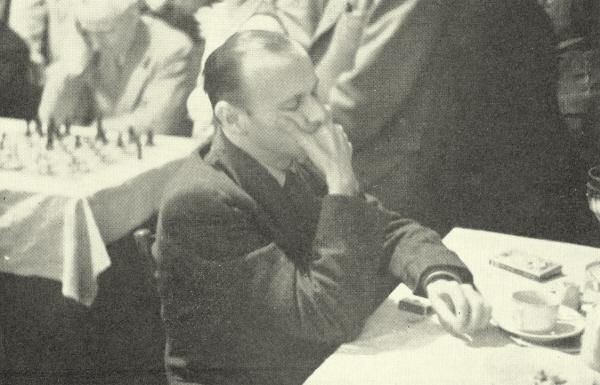
Friedrich (Fritz) Sämisch
Blindfold Chess is, in common with other McFarland books, available from all good chess stockists, or direct from the publisher. The book’s retail price is $65. That is roughly the cost of two crudely-produced print-on-demand paperback reissues of ‘classics’ on which a publisher has expended zero editorial effort.This fine new book by Eliot Hearst and John Knott is likely to give rise to much discussion, and they have set up a special webpage for that purpose:

A paperback edition of the book was issued by McFarland in 2013.
Alexander Alekhine
Toni Preziuso (Suhr, Switzerland) has carried out extensive research into Alekhine’s simultaneous displays in Switzerland. The following blindfold game (ten-board exhibition) was described by Alekhine as ‘the most interesting of the séance’:
Alexander Alekhine – W. Grigorieff
Geneva, 1 October 1925
Queen’s Gambit Declined
1 d4 d5 2 c4 c6 3 e3 Nf6 4 Nc3 e6 5 Nf3 Nbd7 6 Bd3 dxc4 7 Bxc4 b5 8 Bd3 a6 9 O-O Bb7 10 e4 c5 11 e5 Nd5 12 Ng5 Nxc3 13 bxc3 Be7 14 Ne4 Rc8 15 Qg4 Nxe5 16 Qxg7 Ng6 17 Nxc5 Bf8 18 Nxb7 Qe7 19 Nd6+ Qxd6 20 Qf6 Be7 21 Qf3 Nh4 22 Qh3 Rg8 23 Be4 f5 24 Bf3 Rxc3 25 Be3 f4 26 Rac1 Rxc1 27 Bxc1 Qxd4 28 Bc6+ Kf7 29 Re1 Qd6 30 Bf3 e5 31 Bb2 Bf6 32 Rd1 Nxf3+ 33 Qxf3 Qe6 34 Qb7+ Ke8 35 Rc1 Bd8 36 Qe4 Rg5 37 h4 Rh5 38 Rc6 Qd7 39 Qf3 Qf5 40 Re6+ Kf7 41 Rd6 Qb1+ 42 Rd1 Qf5 43 Qd5+ Resigns.
This score is absent from that shoddy book The Games of Alekhine by Rogelio Caparrós and Peter Lahde. So too is the following one, from the same blindfold session:
Alexander Alekhine – Harold Maurice Lommer
Geneva, 1 October 1925
Queen’s Gambit Declined
1 d4 d5 2 c4 c6 3 Nc3 Nf6 4 cxd5 cxd5 5 Bf4 Nc6 6 e3 e6 7 Nf3 Be7 8 Bd3 Bd7 9 h3 Rc8 10 O-O O-O 11 Ne5 Nxe5 12 dxe5 Ne8 13 Qb3 b6 14 Rad1 Bc5 15 Ne2 Qe7 16 Nd4 Nc7 17 Qc2 h6 18 Qe2 f5 19 exf6 Qxf6 20 Bg3 e5 21 Nb3 Rfe8 22 e4 Bc6 23 Nxc5 bxc5 24 f4 c4 25 fxe5 cxd3 26 Rxd3 Qe7 27 Rc3 Bb7 28 Qh5 dxe4 29 Bh4 Qd7 30 Rg3 Re6 31 Bf6 Ne8 32 Qxh6 Rc7 33 Bxg7 Nxg7
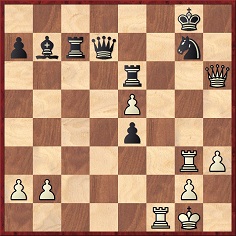
34 Rxg7+ Qxg7 35 Qxe6+ Rf7 36 Rf6 Qf8 37 Rg6+ Kh7 38 Rg4 Kh8 39 Rh4+ Rh7 40 Rxh7+ Kxh7 41 Qd7+ Qg7 42 e6 e3 43 Qd3+ Kh8 44 Qd8+ Kh7 45 Qd3+ Drawn.
In the position of the diagram, both players missed the mate in three beginning with 34 Rf8+, a line subsequently pointed out by a reader of the Tribune de Genève. The source of this material is a privately-prepared booklet by Mr Preziuso, entitled Aljechins Besuche in der Schweiz 1921-1934.
(Kingpin, 1993-94)
The Alekhine v Lommer game would seem to be the one referred to by Bruce Hayden on page 14 of Cabbage Heads and Chess Kings:
‘... back in 1925, the 21-year-old composer [i.e. Lommer, who in fact was not quite 21] was picked to face Alekhine in one of his exhibition games at Geneva.
He shook that great master and the onlookers with a variation which left him with a won game. He shook the onlookers much more later by letting His Greatness get away with a draw.’
Does the play justify this description?
(Kingpin, 1995)
We have received the following game from Luc Winants (Boirs, Belgium):
Alexander Alekhine (blindfold) – Léon Neirynck
Brussels, 18 March 1922
English Opening
1 c4 e5 2 g3 Nf6 3 Bg2 c6 4 Nc3 Bb4 5 Nf3 d6 6 d4 exd4 7 Nxd4 Be6 8 Nxe6 fxe6 9 Qb3 Na6 10 O-O Rb8 11 Bf4 e5 12 Be3 Bc5 13 Bxc5 Nxc5 14 Qc2 O-O 15 Rad1 Qe7 16 Rd2 Rbd8 17 h3 Ne6 18 e3 Nd7 19 Ne4 Ndc5 20 h4 Nxe4 21 Qxe4 Nc5 22 Qc2 Rf6 23 b4 Ne6 24 Qe4 Rf7 25 Bh3 Nc7 26 f4 exf4 27 Rxf4 Rdf8 28 Qxe7 Rxe7 29 Rxf8+ Kxf8 30 Rxd6 Rxe3 31 Rd7 Re7 32 Kf2 Rxd7 33 Bxd7 Drawn (at the proposal of Black).
Source: La Nation Belge, 29 March 1923 [sic]. The occasion was a 12-board blindfold display.
(4700)
C.N. 5888 noted that the complete archives of the Journal de Genève are available on-line, and now Dominique Thimognier (St Cyr sur Loire, France) points out a report by the Genevese psychologist Edouard Claparède on page 5 of the newspaper’s 4 October 1925 issue. It concerns a ten-board blindfold exhibition given by Alekhine in Geneva three days previously and includes an explanation of how he played sans voir:
‘Je ne vois devant moi, m’a déclaré M. Alekhine, qu’une surface très vague, représentant l’échiquier, surface non colorée et vaguement divisée en casiers. Mais, si je puis me diriger dans ma partie, ce n’est pas parce que je vois les pions, mais parce que je sais où ils sont. Chaque case de l’échiquier a un sens pour moi, et chaque indication d’un coup correspond à un mouvement que je vois.’
Claparède also recounted that Alekhine submitted himself to some psychological tests. These indicated that in matters unrelated to chess (memorizing words, geometrical shapes and objects) Alekhine’s performance was average, whereas in memorizing chess positions he excelled. Claparède randomly placed 12 pieces (six white, six black) on a chessboard, and after looking at the position for 15 seconds Alekhine had perfect recall of where all the pieces stood:
‘M. Alekhine a bien voulu accepter de se soumettre, au laboratoire de psychologie, à quelques expériences, malheureusement trop restreintes, étant donné le peu de temps dont nous disposions. Elles ont suffi cependant pour montrer que, dans les domaines qui n’ont rien à faire avec les échecs (mémoire des mots, des figures géométriques, des objets), notre champion ne sort guère de l’honnête moyenne. Au contraire, dès que l’expérience de mémoire a pour objet un échiquier avec ses pièces, bond prodigieux: M. Alekhine laisse bien loin derrière lui les simples mortels que nous sommes. En voici un exemple: J’ai placé au hasard, sur un échiquier, 12 pièces, six blanches et six noires, comprenant les principales figures du jeu d’échecs. Après avoir regardé l’échiquier garni, pendant quinze secondes seulement, M. Alekhine est parvenu à rétablir d’une façon parfaitement exacte la position qu’occupait chacune de ces douze pièces. La même expérience, répétée avec deux collègues qui m’assistaient, et avec moi-même, n’a donné que trois à quatre reproductions justes sur douze.’
(5992)
From page 515 of Alexander Alekhine’s Chess Games, 1902-1946 by Leonard M. Skinner and Robert G.P. Verhoeven (Jefferson, 1998):
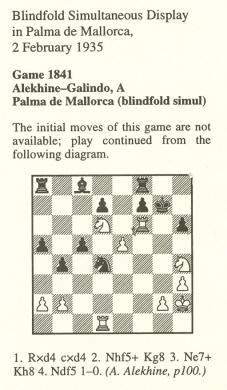
The source indicated (A. Alekhine) is the English-language edition of Pablo Morán’s monograph (Jefferson, 1989).
Andrés Vicente Sanz (Valencia, Spain) has sent us the complete game as published on page 3 of El Mundo Deportivo, 7 February 1935:
Alexander Alekhine – A. Galindo
Blindfold exhibition, Palma de Mallorca, 2 February 1935
Ruy López
1 e4 e5 2 Nf3 Nc6 3 Bb5 Bc5 4 c3 Nf6 5 d4 exd4 6 e5 Nd5 7 cxd4 Bb4+ 8 Bd2 Bxd2+ 9 Qxd2 Nce7 10 Nc3 c6 11 Bc4 b5 12 Bb3 O-O 13 Ne4 Ng6 14 Nd6 Qe7 15 O-O Qe6 16 h3 Ngf4 17 Bxd5 Nxd5 18 Ng5 Qg6 19 f4 h6 20 Nf3 a5
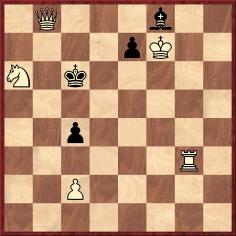
21 f5 Qg3 22 f6 Qf4 23 fxg7 Kxg7 24 Qxf4 Nxf4 25 Nh4 Ne2+ 26 Kh2 Nxd4 27 Rf6 b4 28 Rd1 c5 29 Rxd4 cxd4 30 Nhf5+ Resigns.
(6390)
Pages 14-15 of 100 Classics of the Chessboard by A.S.M. Dickins and H. Ebert (Oxford, 1983) gave Alekhine v Sämisch, Berlin, 1923 under the heading ‘The Classic Blindfold Game’. The co-authors claimed:
‘Happening to meet in Berlin, the two players decided to take the opportunity of playing each other blindfold, creating as a result this astonishing brilliancy.’
The book added that Sämisch called Alekhine’s victory ‘the most brilliant game I have ever seen’. The moves: 1 e4 c5 2 Nf3 Nc6 3 Be2 e6 4 O-O d6 5 d4 cxd4 6 Nxd4 Nf6 7 Bf3 Ne5 8 c4 Nxf3+ 9 Qxf3 Be7 10 Nc3 O-O 11 b3 Nd7 12 Bb2 Bf6 13 Rad1 a6 14 Qg3 Qc7 15 Kh1 Rd8 16 f4 b6 17 f5 Be5 18 fxe6 Bxg3 19 exf7+ Kh8 20 Nd5 Resigns.
It is one of Alekhine’s most spectacular miniatures, number 97 in his first collection of Best Games (London, 1927). The heading was ‘Exhibition Game played at Berlin, February 1923’. The book did not suggest that either master was blindfold. Nor did the German translation, Meine besten Partien 1908-1923 (Berlin and Leipzig, 1929), although we have one later edition in German (Berlin, 1983), which states ‘Beiderseits ohne Ansicht des Brettes’. Various editions of the book Meisterspiele by Rudolf Teschner say that both players were without sight of the board, and Sämisch’s praise of Alekhine is quoted:
‘“Die genialste Partie, die ich je gesehen habe”, äußerte Sämisch voll Bewunderung für seinen Gegner.’
As shown below, Tartakower cited Sämisch when he published the game (a ‘Gastkampf’ , which Tartakower dated 1921, instead of 1923, with no intimation of blindfold play but with an additional move at the end) on page 276 of Die hypermoderne Schachpartie (Vienna, 1924):
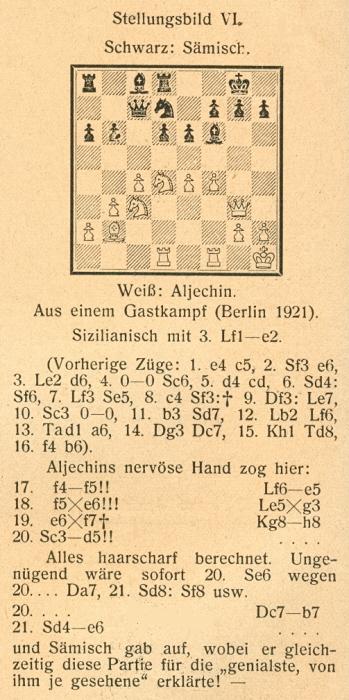
January, rather than February, 1923 was specified when the game appeared on pages 218-219 of the second volume of Complete Games of Alekhine by V. Fiala and J. Kalendovský (Olomouc, 1996). The co-authors asserted that the game was first published on page 16 of the Observer, 4 March 1923. In neither that volume nor in the Skinner/Verhoeven book on Alekhine (see page 184) was it suggested that Alekhine or Sämisch played the game blindfold. Moreover, the score was not included in Blindfold Chess by E. Hearst and J. Knott (Jefferson, 2009).
The brilliancy is absent from all the chess magazines of 1923 that we have consulted so far.
(6741)
Two photographs from the Illustrated London News which have been provided by Olimpiu G. Urcan:
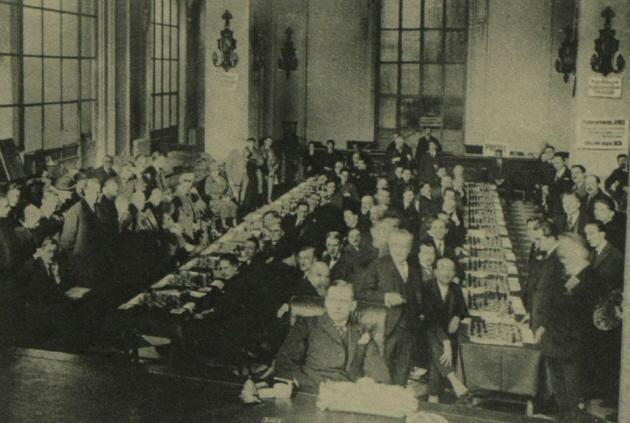
Alexander Alekhine (blindfold exhibition in Paris). 25 February 1925, page 205
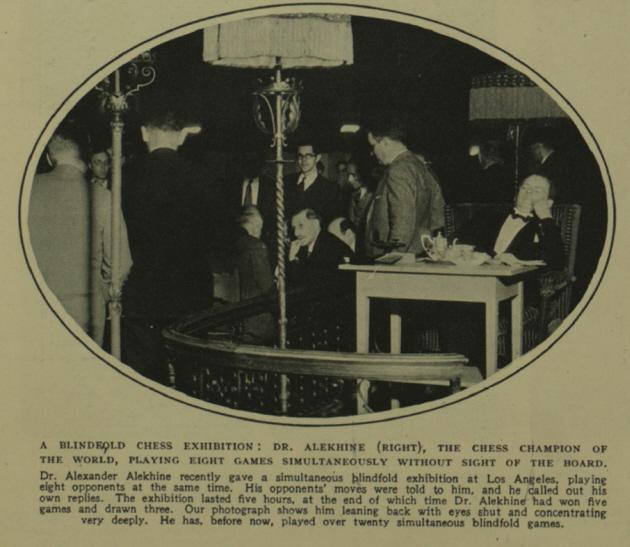
1 October 1932, page 498
(7490)
An exceptionally difficult quiz question:
‘After his blindfold displays he would drink brandy in ordinary tumblerfuls.’
Who wrote that about Alekhine?
(8947)
Suggestions included Arnold Denker and Harold C. Schonberg, but the most popular answer, in view of possible Internet searches, was Thomas Olsen.
From page 188 of The Great Chess Masters and Their Games by Fred Reinfeld (New York, 1952), in the chapter on Alekhine:

The previous year Reinfeld had included the following on pages 197-198 of The Treasury of Chess Lore (New York, 1951):
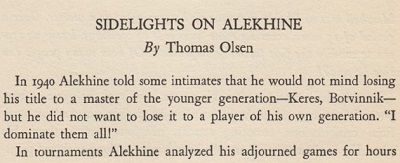
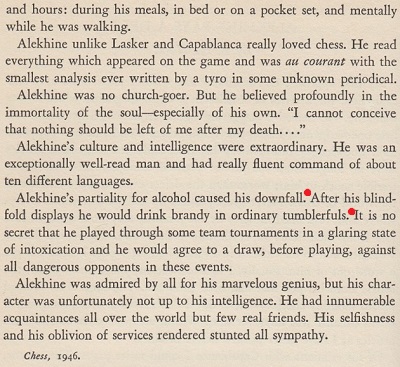
The next step is to verify that the quote is indeed in the magazine CHESS. Below is the relevant part of the May 1946 edition (pages 169-172):
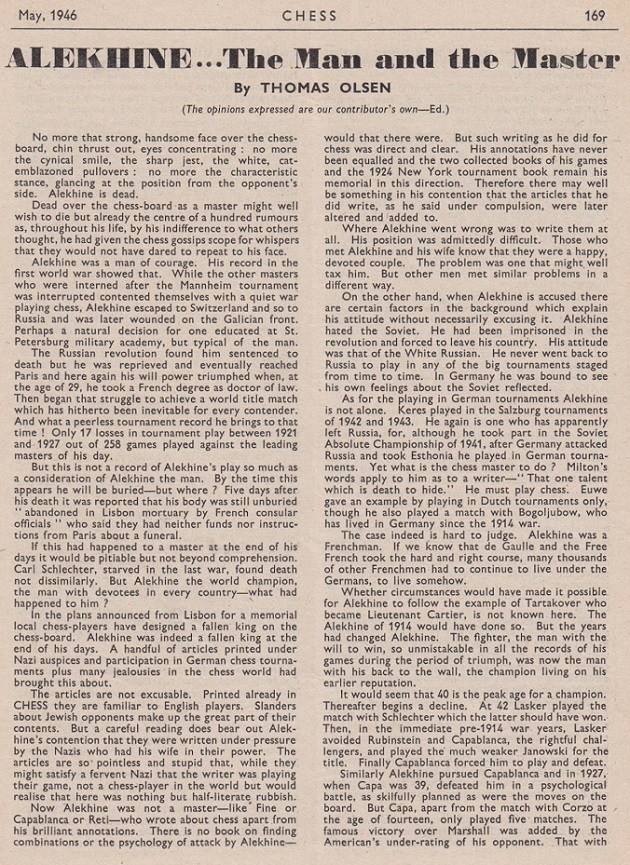
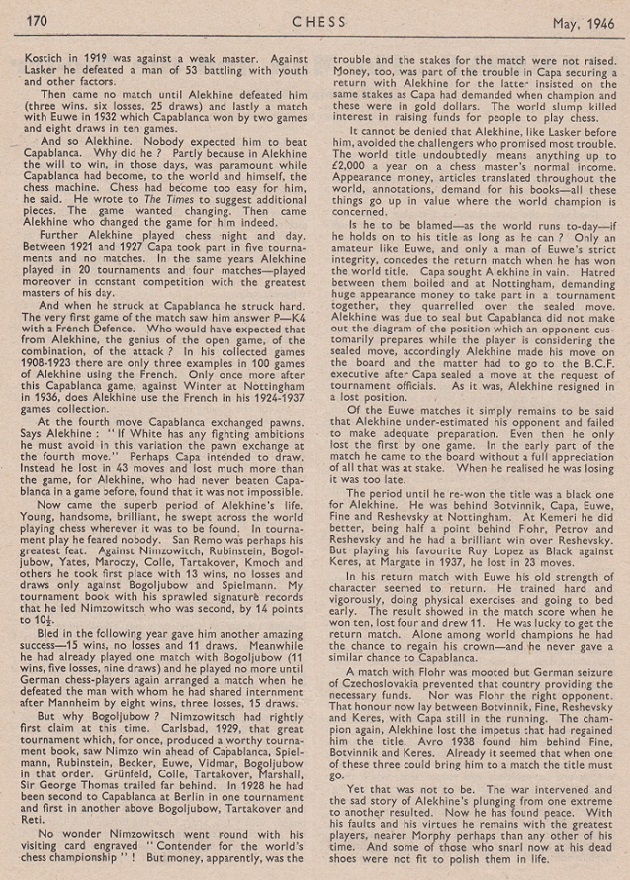
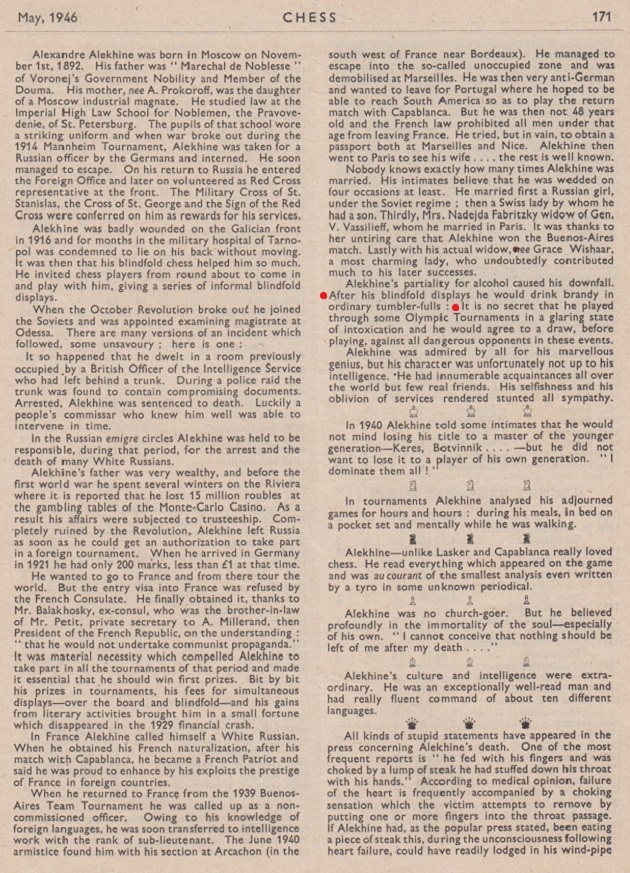
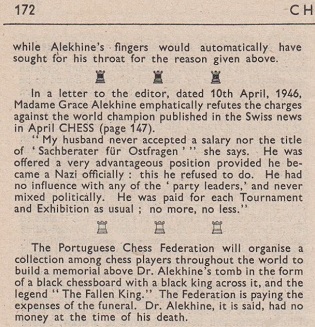
However, if Thomas Olsen were the evident answer to our poser, C.N. 8947 would not have described the question as ‘exceptionally difficult’.
Page 198 of the June 1946 CHESS stated:
‘ALEKHINE NOTES (continued)
In the May number of CHESS owing to a technical mistake the above title was omitted from the top of page 171. Mr Thomas Olsen’s article “Alekhine ... The Man and the Master” finishes with page 170, and the notes which follow are not from his pen.’
Consequently, Reinfeld’s later attributions to Olsen are incorrect, as is the reference in C.N. 7209 to ‘a three-page feature “Alekhine ... The Man and the Master” by Thomas Olsen’.
It is now tempting to assume that the writer of the remaining Alekhine material in the May 1946 CHESS was the magazine’s editor, B.H. Wood, but that is not so. Page 44 of the 12 November 1955 CHESS carried a review of Reinfeld’s The Treasury of Chess Lore which included this correction:
‘There are several quotations from CHESS; one of these (page 197), probably through our not making the authorship clear ourselves, is ascribed to Thomas Olsen instead of B. Reilly.’
How much unsigned material Brian Reilly wrote for CHESS naturally cannot be known, but in the mid-1940s he was indeed working for the magazine, as he informed W.H. Cozens on page 360 of the September 1981 BCM.
(8950)
The Gallica website of the Bibliothèque Nationale de France has a photograph of Alekhine playing blindfold at the Café de la Rotonde au Palais-Royal in Paris.
(10114)
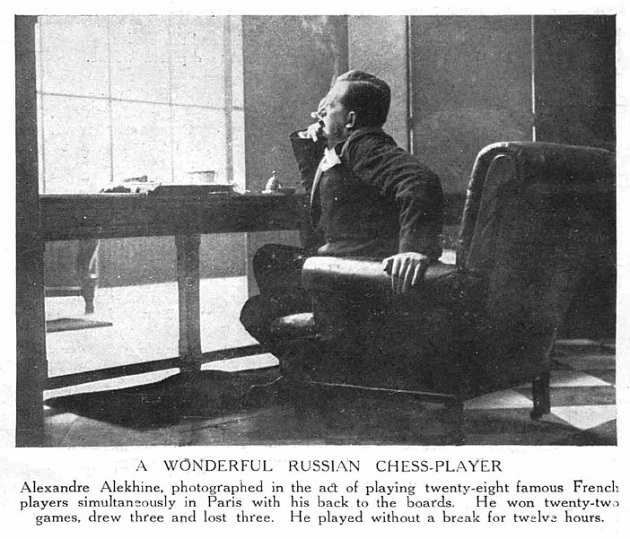
The above photograph, from page 191 of The Graphic, 7 February 1925, was shown in C.N. 10302.
Arthur Larrue (Lisbon) informs us that the Gallica website has a different shot, of high quality, taken at the same locale.
(10733)
On page 43 of issue 27 of Kingpin (Summer 1997) we discussed Gleason v Alekhine, Chicago, 9 February 1924, which both sides played blindfold. (See pages 305-306 of Kings, Commoners and Knaves.)
The score as given on page A3 of the Brooklyn Daily Eagle, 21 February 1924:
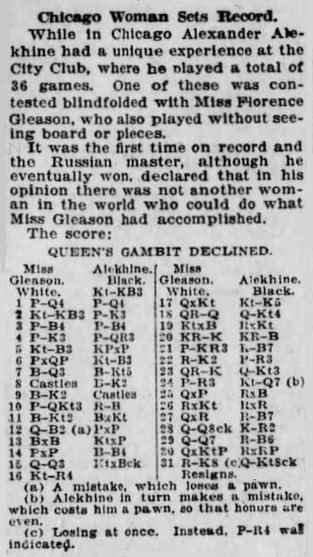
1 d4 Nf6 2 Nf3 d5 3 c4 e6 4 e3 c5 5 Nc3 a6 6 cxd5 exd5 7 Bd3 Nc6 8 O-O Bg4 9 Be2 Be7 10 b3 O-O 11 Bb2 Rc8 12 Qc2 Bxf3 13 Bxf3 cxd4 14 exd4 Nxd4 15 Qd3 Bc5 16 Na4 Nxf3+ 17 Qxf3 Ne4 18 Rad1 Qg5 19 Nxc5 Rxc5 20 Rfe1 Rfc8 21 h3 Rc2 22 Re2 h6 23 Rde1 Qg6 24 a3 Nd2 25 Qxd5 Rxb2 26 Rxd2 Rxd2 27 Qxd2 Rc2 28 Qd8+ Kh7 29 Qd7 Rc3 30 Qxb7 Rxh3 31 Re8 Qb1+ 32 White resigns.
A photograph taken during Alekhine’s exhibition, with Florence Gleason mentioned in the caption, was shown in C.N. 4985. Information about her is still sought.
(10183)
See also An Alekhine Blindfold Game (against Frieman) and ‘The Immortal Blindfold Game’ (against Schwartz).
Newell Williams Banks
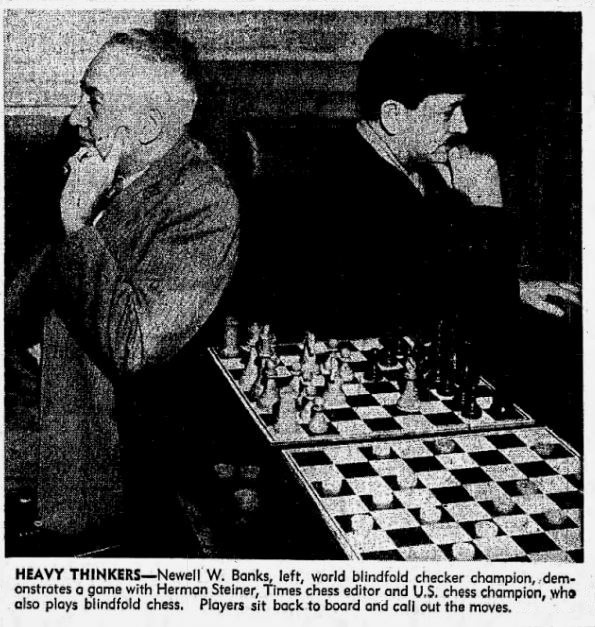
Source: Los Angeles Times, 29 December 1950, part 2, page 1.
(10209)
See also Newell Williams Banks.
Joseph Henry Blackburne
Efim Bogoljubow
See Efim Bogoljubow.
Julius Breyer
See our feature article on him.
José Raúl Capablanca
Capablanca’s limited interest in blindfold chess is well known. For example, page 21 of our monograph on the Cuban quoted his comments on page 10 of the Montreal Daily Herald, 18 November 1909:
‘I don’t care much for blindfolded chess, and other stunts like that. ... I’ve played that way, but it seems to me too much like charlatanism.’
A photograph in José Antonio Gelabert’s 1923 book on Capablanca:
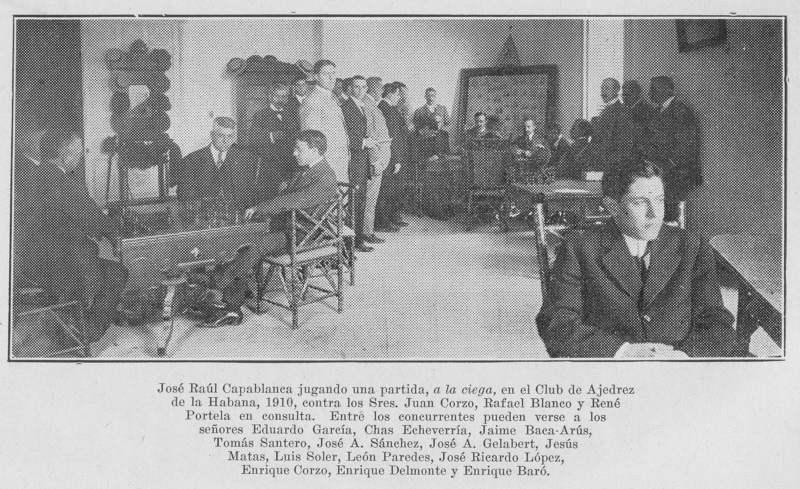
See too The Capablanca v Price/Baca-Arús Mystery.
From page 100 of The Unknown Capablanca by David Hooper and Dale Brandreth (London, 1975):
‘He found cable matches boring; when asked why he did not give simultaneous blindfold displays he answered, “Why should I kill myself?’”
No source for the Capablanca quote was given.
Mikhail Chigorin
Graham Clayton (South Windsor, NSW, Australia) submits two games played by Chigorin in an eight-board blindfold exhibition at the Manhattan Chess Club and published on page 2 of the New York Times, 26 May 1889:
Mikhail Chigorin – B. Hoffman
New York, 25 May 1889
Evans Gambit Accepted
1 e4 e5 2 Nf3 Nc6 3 Bc4 Bc5 4 b4 Bxb4 5 c3 Ba5 6 O-O Nf6 7 d4 O-O 8 dxe5 Nxe4 9 Bd5 Nc5 10 Ng5 h6 11 Nxf7 Rxf7 12 Bxf7+ Kxf7 13 Qd5+ Ne6 14 f4 Bb6+ 15 Kh1 Ne7 16 Qf3 Kg8 17 f5 Ng5 18 Qh5 Ne4
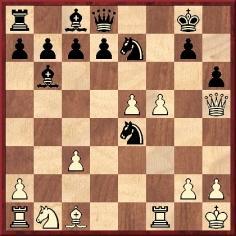
19 f6 Nf2+ 20 Rxf2 Bxf2 21 Bxh6 gxh6 22 Qxh6 Qf8 23 Qg5+ Ng6 24 Qxg6+ Kh8 25 Nd2 d5 26 Rf1 Be3
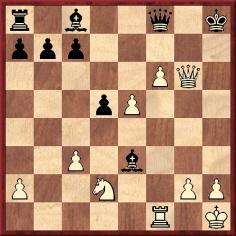
27 Rf3 Bxd2 28 g4 Qh6 29 Rh3 Resigns.
Mikhail Chigorin – Julius Livingstone
New York, 25 May 1889
Danish Gambit
1 e4 e5 2 d4 exd4 3 c3 dxc3 4 Nxc3 Bb4 5 Nf3 Bxc3+ 6 bxc3 c6 7 Bc4 Ne7 8 Qd6 O-O 9 Bg5 Qa5
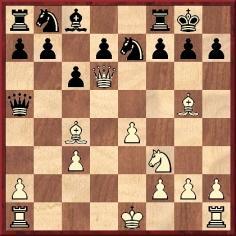
10 Bxe7 Qxc3+ 11 Nd2 Qxa1+ 12 Ke2 Qxh1 13 Bxf8 Qxg2 14 Qe7 d5 15 Qd8 Qg4+ 16 f3 Qd7 17 White resigns.
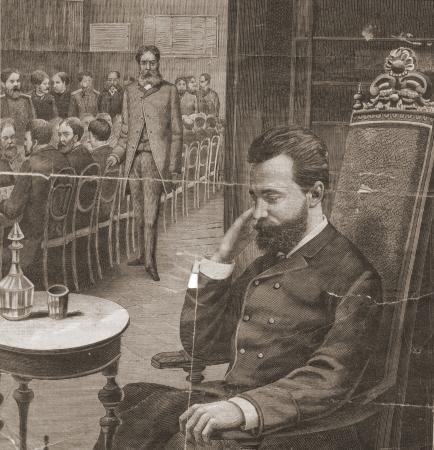
Mikhail Chigorin, Niva, 1888, page 444
(5686)
Another version of the engraving of Chigorin playing blindfold, published on page 444 of the 23 April 1888 edition of Niva:
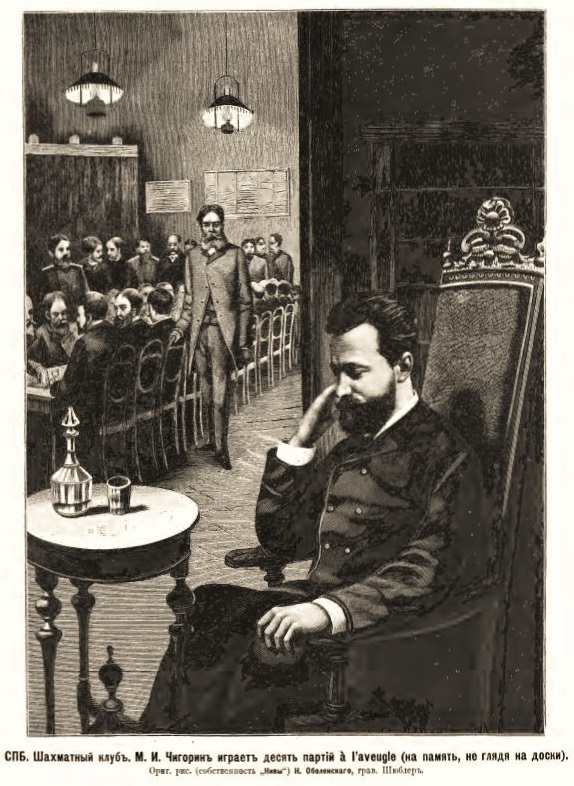
(11180)
Jens Enevoldsen
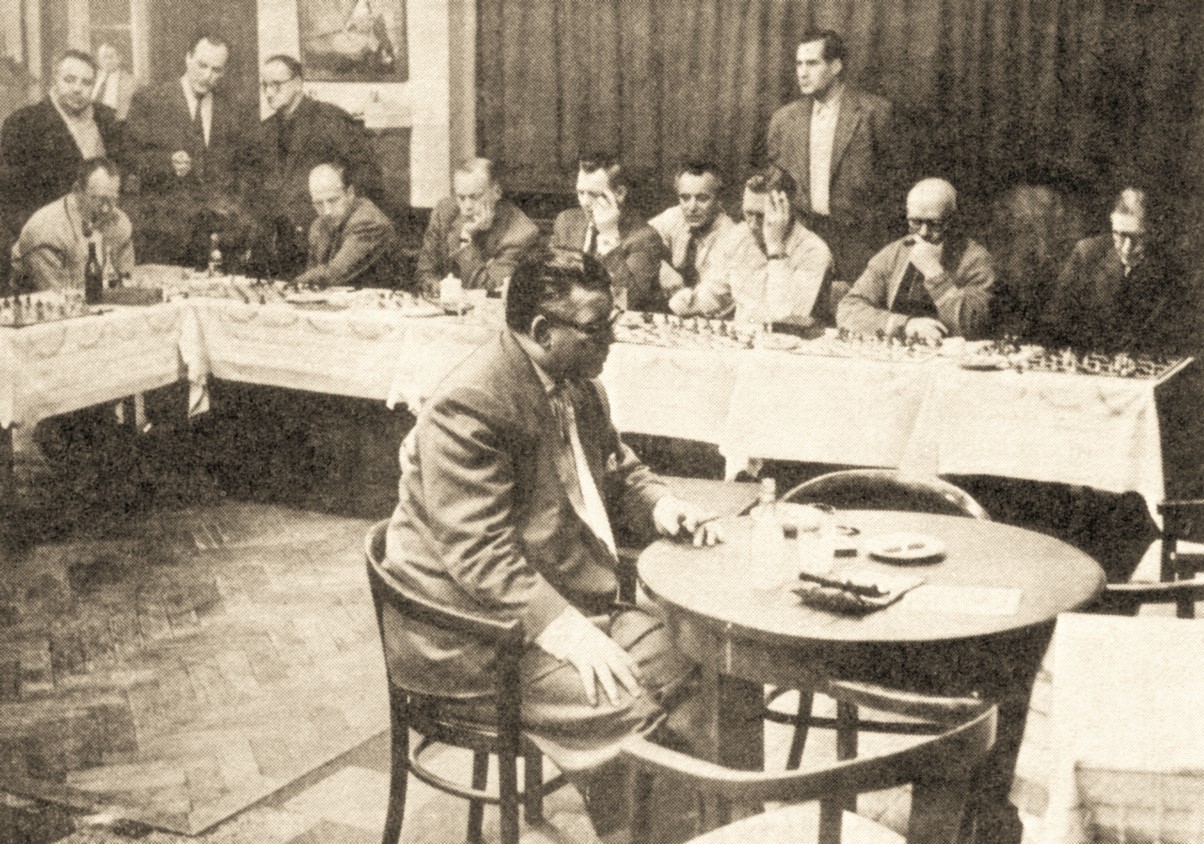
Reuben Fine
From page 29 of the November 1945 Chess Review:

The best coverage of his chess career is in Reuben Fine by Aidan Woodger (Jefferson, 2004).
Max Fleissig
From the Westminster Papers, 1 June 1872, page 19:
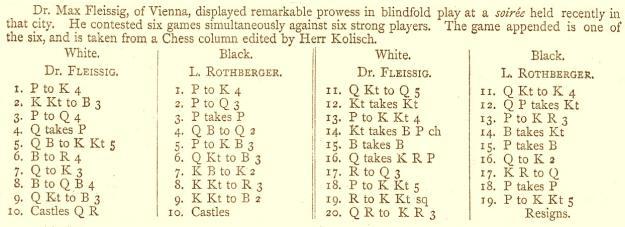
Max Fleissig – L. Rothberger
Vienna, 1872
Philidor’s Defence
1 e4 e5 2 Nf3 d6 3 d4 exd4 4 Qxd4 Bd7 5 Bg5 f6 6 Bh4 Nc6 7 Qe3 Be7 8 Bc4 Nh6 9 Nc3 Nf7 10 O-O-O O-O 11 Nd5 Nce5 12 Nxe5 dxe5 13 g4 h6
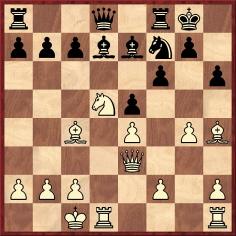
14 Nxf6+ Bxf6 15 Bxf6 gxf6 16 Qxh6 Qe7 17 Rd3 Rfd8 18 g5 fxg5 19 Rg1 g4 20 Rh3 Resigns.
(7608)
Peter Anderberg (Harmstorf, Germany) adds that all six games in the exhibition were published in the report on pages 3-6 of the Oesterreichische Schachzeitung, 1 April 1872:
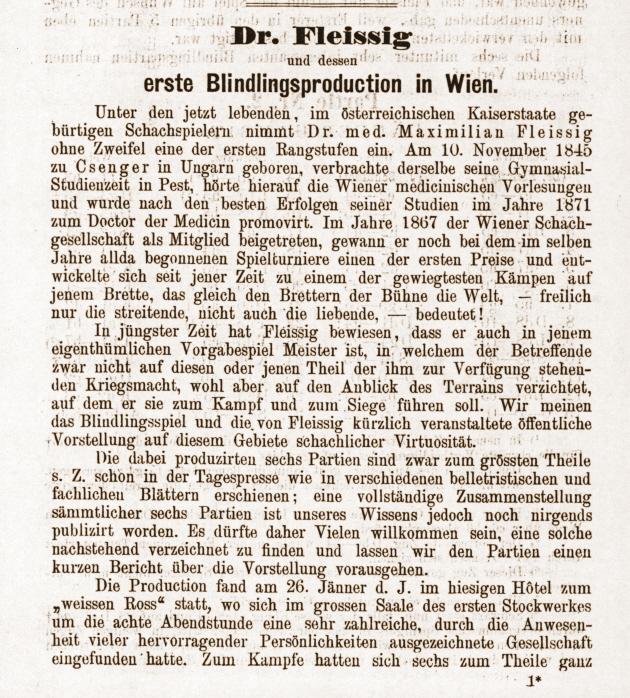
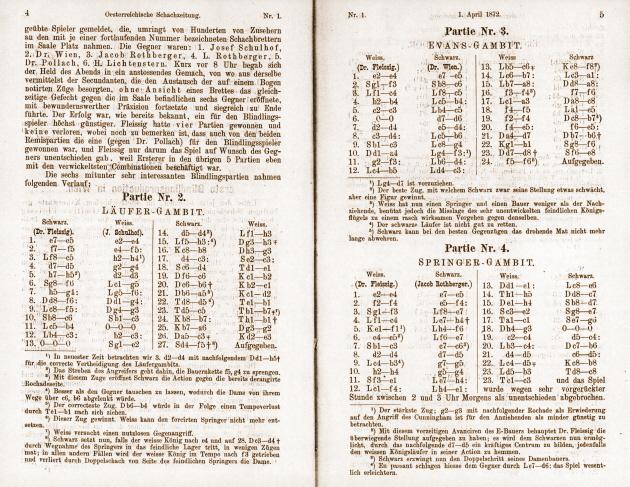
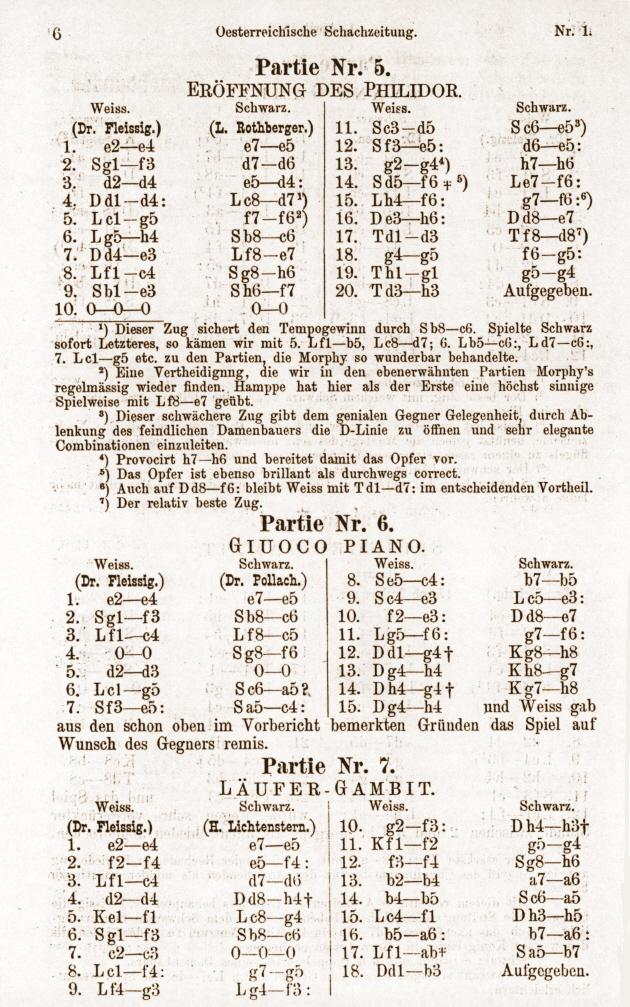
Below are the five games not given in C.N. 7608:
Max Fleissig – Josef Schulhof
Vienna, 26-27 January 1872
King’s Gambit Accepted
1 e4 e5 2 f4 exf4 3 Bc4 h5 4 d4 g5 5 h4 d6 6 Nf3 Bg4 7 hxg5 Bxf3 8 Qxf3 Qxg5 9 Bxf4 Qg6 10 Nc3 Nc6 11 Bb5 O-O-O 12 Bxc6 bxc6 13 O-O-O Ne7 14 d5 Bh6 15 Bxh6 Qxh6+ 16 Kb1 Qg6 17 dxc6 Nxc6 18 Nd5 Rde8 19 Qc3 Kb7 20 Qb3+ Kc8 21 Qa4 Kd7
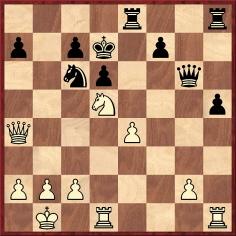
22 Rd4 Rb8 23 Rc4 Rxb2+ 24 Kxb2 Rb8+ 25 Ka3 Qg7 26 Qxc6+ Ke6 27 Nf4+ Resigns.
Max Fleissig – Wien
Vienna, 26-27 January 1872
Evans Gambit Accepted
1 e4 e5 2 Nf3 Nc6 3 Bc4 Bc5 4 b4 Bxb4 5 c3 Bc5 6 O-O d6 7 d4 exd4 8 cxd4 Bb6 9 Nc3 Bg4 10 Qa4 Bxf3 11 gxf3 Bxd4
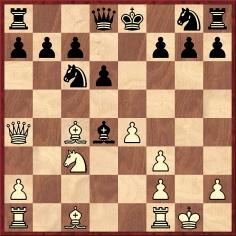
12 Bb5 Bxc3 13 Bxc6+ Kf8 14 Bxb7 Bxa1 15 Bxa8 Qxa8 16 f4 f6 17 Ba3 Qc8 18 f5 Be5 19 f4 Qb7 20 fxe5 fxe5 21 Qd7 Qb6+ 22 Kh1 Nf6 23 Qd8+ Ne8 24 f6 Resigns.
Max Fleissig – Jacob Rothberger1 e4 e5 2 f4 exf4 3 Nf3 Be7 4 Bc4 Bh4+ 5 Kf1 Bf6 6 e5 Be7 7 Nc3 c6 8 d4 d5 9 Bb3 g5 10 h4 g4 11 Ne1 Bxh4 12 Bxf4 Bxe1 13 Qxe1 Be6 14 Rh5 Qc7 15 Qh4 Nd7 16 Ne2 Ne7
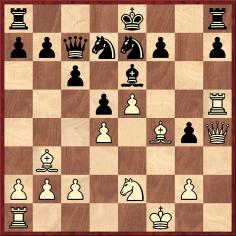
17 Rc1 Ng6 18 Qg3 O-O-O 19 c4 dxc4 20 Bxc4 Qb6 21 d5 cxd5 22 Bxd5+ Kb8 23 Bb3 Rc8 24 Rc3 Drawn.
Max Fleissig – Pollach
Vienna, 26-27 January 1872
Giuoco Piano
1 e4 e5 2 Nf3 Nc6 3 Bc4 Bc5 4 O-O Nf6 5 d3 O-O 6 Bg5 Na5 7 Nxe5 Nxc4 8 Nxc4 b5 9 Ne3 Bxe3 10 fxe3 Qe7 11 Bxf6 gxf6 12 Qg4+ Kh8 13 Qh4 Kg7 14 Qg4+ Kh8 15 Qh4 Drawn.
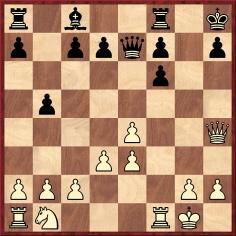
Max Fleissig – H. Lichtenstern
Vienna, 26-27 January 1872
King’s Gambit Accepted
1 e4 e5 2 f4 exf4 3 Bc4 d6 4 d4 Qh4+ 5 Kf1 Bg4 6 Nf3 Nc6 7 c3 O-O-O 8 Bxf4 g5 9 Bg3 Bxf3 10 gxf3 Qh3+ 11 Kf2 g4 12 f4 Nh6
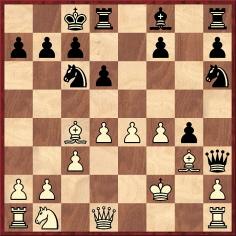
13 b4 a6 14 b5 Na5 15 Bf1 Qh5 16 bxa6 bxa6 17 Bxa6+ Nb7 18 Qb3 Resigns.
(7661)
Peter Anderberg has found this detailed report on pages 6-7 of the 28 January 1872 edition of Neue Freie Presse:
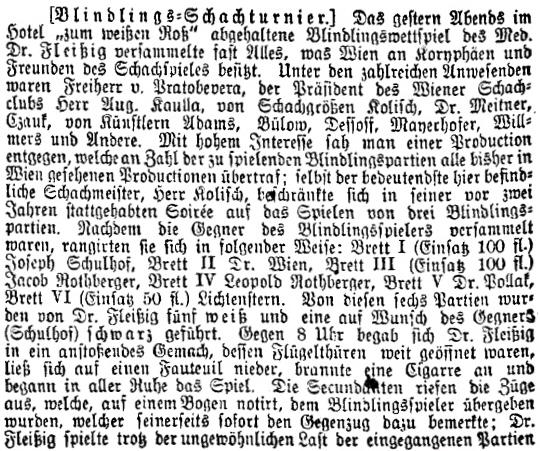
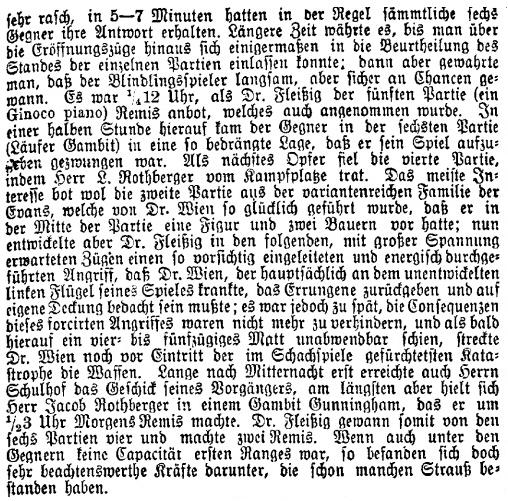
(7675)
János Flesch
Eliot Hearst and John Knott are studying the history of blindfold chess and are looking for information about the exact circumstances of the alleged simultaneous exhibition world record by János Flesch in Budapest in 1960. Two Hungarian correspondents – Iván Bottlik (Budapest) and Zoltán Blázsik (Szeged) – have drawn our attention to the report on page 172 of the November 1960 Magyar Sakkélet [see below]. Can anyone take the story further? Messrs Hearst and Knott are also seeking documentation about, inter alia, the blindfold records set by Najdorf.
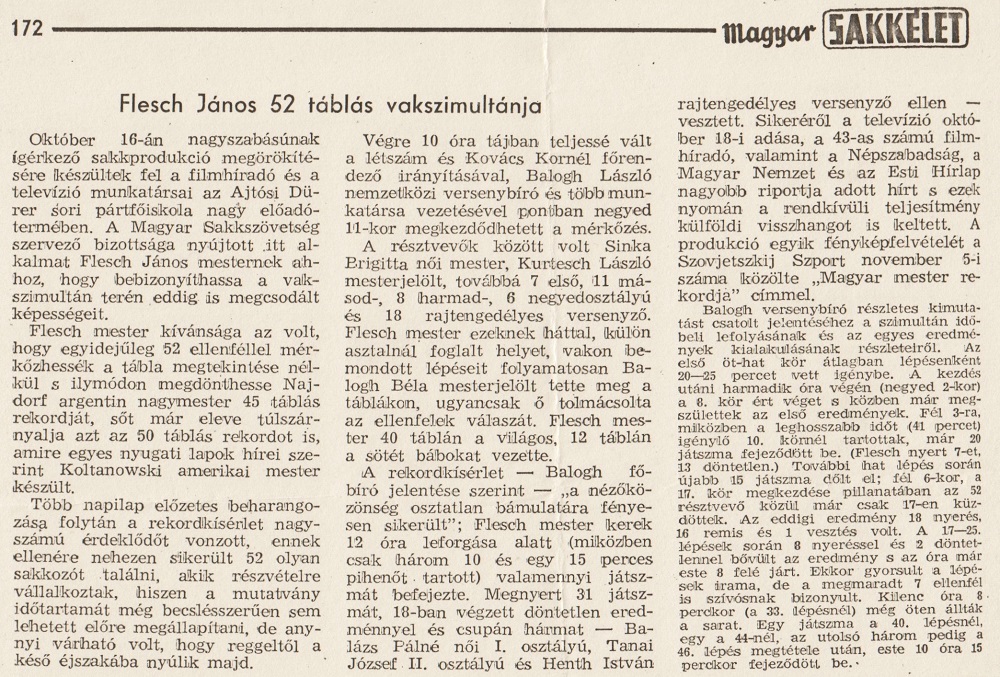
(2087)
Eliot Hearst informs us that the extensive volume on blindfold chess (including historical and psychological aspects) that he is writing jointly with John Knott is nearing completion, and here he raises two questions:
‘Firstly, we know that J.O. Hansen broke Enevoldsen’s 1939 Nordic record of 24 simultaneous blindfold games by playing 25 on 24 May 1986. Moreover, John Knott was informed by a Danish chess contact in October 2002 that O.B. Larsen of Denmark had surpassed Hansen’s record by playing 28 games. Can anyone validate this new record and indicate when and where it occurred? We should also like to find out more about the tournament and blindfold career of O.B. Larsen.
Secondly, a few years before his death in 1983, Janos Flesch claimed in a written statement to John Knott that his 52-board blindfold display in Budapest in 1960 had been “duly ratified by FIDE as the new world record”? Can a FIDE official or other chess authority/historian tell us whether this claim is true and, if so, what other simultaneous blindfold records have been “ratified by FIDE”?’
(3329)
Eliot Hearst (Tucson, AZ, USA) reverts to a matter he raised in C.N. 3329:
‘A few years before his death in 1983, János Flesch claimed in a written statement to John Knott that his 52-board blindfold display in Budapest in 1960 had been “duly ratified by FIDE as the new world record”. Can a FIDE official or other chess authority/historian tell us whether this claim is true and, if so, what other simultaneous blindfold records have been “ratified by FIDE”?’
Following the earlier appearance of these questions from Professor Hearst we wrote to FIDE, but our enquiry (dated 6 June 2004) received no reply.
Personal chess records (such as the number of opponents faced simultaneously and the oldest grandmaster) are a popular topic for discussion, but no effort seems to have been made, by any organization, publisher or individual, to list the facts systematically and dependably, in the way that Tim Krabbé has done for over-the-board records (such as the latest castling and the longest symmetrical game).
An addition to Chess Masters on Film is some footage of János Flesch playing blindfold chess.
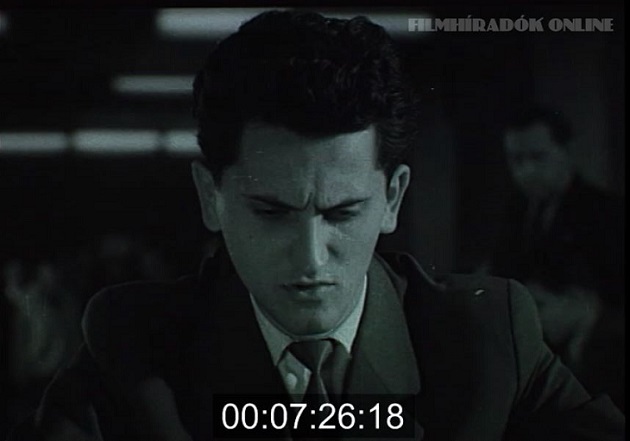
(11676)
Alexander Fritz
Although it can be retorted that the ability to play sans voir is no measure of world-beating chess skill, it remains an arresting and inconvenient truth that a forgotten nineteenth-century player such as Alexander Fritz (1857-1932) could play 12 blindfold games simultaneously, a feat that would, at least, stretch most of today’s masters. A report of Fritz’s exploits appeared on page 172 of the June 1880 Deutsche Schachzeitung, and below is one of his games, also forgotten, from a four-board blindfold exhibition.
Alexander Fritz (blindfold) – A. Hensel
Darmstadt, September 1877
Sicilian Defence
1 e4 c5 2 d4 d6 3 Nf3 Nf6 4 Nc3 cxd4 5 Nxd4 e5 6 Bb5+ Bd7 7 Nf5 Nc6 8 Nxd6+ Bxd6 9 Qxd6 a6 10 Bg5 h6
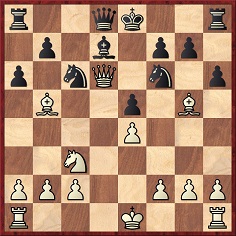
11 Nd5 Rc8 12 Bxf6 Qa5+ 13 c3 Qxb5 14 O-O-O Be6 15 Nc7+ Rxc7 16 Qd8+ Nxd8 17 Rxd8 mate.
Source: Deutsche Schachzeitung, October-November 1878, pages 336-337.
(Chess Café, 1997)
Daniel Harrwitz
Bernhard Horwitz and George Perigal – Daniel Harrwitz
(blindfold)
London, 1846 or 1847
(Remove White’s queen’s rook.)
1 e4 e5 2 Bc4 Nf6 3 Nf3 Nc6 4 Ng5 d5 5 exd5 Na5 6 Bb5+ Bd7 7 Qe2 Bd6 8 Bxd7+ Qxd7 9 c4 b6 10 Nc3 O-O 11 O-O Nb7 12 d3 Rae8 13 Kh1 h6 14 Nh3 Qg4 15 f3 Qh5 16 Nb5 e4 17 Qd1 exf3 18 Rxf3 Re7 19 Bd2 Ng4 20 Nxd6 Nxd6 21 Qg1 Rfe8 22 Nf4 Qh4 23 g3 Qf6 24 Bc3 Qf5 25 h3 Ne5 26 Qd4 f6 27 Rf2 h5 28 Kg2 Ndf7 29 b4 Ng5 30 c5 Nef3 31 Qc4 Ne1+ 32 Bxe1 Rxe1 33 d6+ Kh7 34 h4 Ne6 35 Nd5 Qg4 36 Qxg4 hxg4 37 d7 Rd8 38 c6 Re5 39 Nc3 Nd4 40 b5 Nxb5 41 Nxb5 Rxb5 42 d4 Kg6 43 Re2 Kf7 44 Kf2 Rf5+ 45 Ke3 Rd5 46 Kd3 Rd6 47 Rc2 Rf8 48 Ke4 Ke6 49 Re2 f5+ 50 Kd3+ Kf7 51 Rc2 Ke7 52 a4 Rff6 53 Re2 Rde6 54 Rxe6+ Rxe6 55 d5 Rd6 56 Kd4 g6
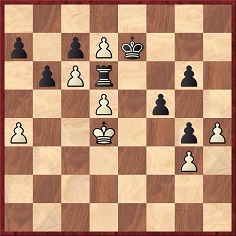
57 Ke5 a6 58 Kd4 b5 59 axb5 axb5 60 Ke5 b4 61 Kd4 Rxd5+ 62 Kxd5 b3 63 Ke5 b2 64 Kf4 b1(Q) 65 Kg5 Qe4 66 h5 gxh5 67 Kxh5 Qxc6 68 Kg5 Qxd7 69 Kg6 Qe6+ 70 Kg5 Kf7 71 Kf4 Kg7 72 Kg5 Qe4 73 Kh5 Kf6 74 K moves Qh1 mate.
Source: Chess Player’s Chronicle, 30 January 1847, pages 33-34. Staunton’s magazine commented: ‘It is not often, over the chess board even, that anything finer or truer is seen than the play of Black throughout this game. When one looks at the precision of these latter moves, and remembers under what circumstances they were played, the whole thing becomes a marvel, as curious as it is inexplicable.’ The game lasted five hours.
(2153)
Pages 69-70 of A Chess Omnibus, gave this game, one of two played simultaneously and blindfold by Harrwitz:
Daniel Harrwitz – Smith and Bogle
Glasgow, 1848
Evans Gambit Accepted
1 e4 e5 2 Nf3 Nc6 3 Bc4 Bc5 4 b4 Bxb4 5 c3 Ba5 6 O-O Bb6 7 d4 exd4 8 cxd4 d6 9 Bb2 Nf6 10 d5 Na5 11 Bd3 O-O 12 Nbd2 c5 13 Qc2 h6 14 h3 Qe7 15 Rae1 Nh5 16 e5 Bc7 17 Re4 dxe5 18 Nxe5 Qd6 19 f4 Bf5 20 g4 Bxe4 21 Nxe4 Qxd5 22 gxh5 b6 23 Ng3 Rad8 24 Rd1 Qe6 25 Kh2 Nc6 26 Bf5 Nb4 27 Qg2 Qe8 28 Ne4 Bxe5 29 Bxe5 Qxe5 30 fxe5 Rxd1 31 a3 Na6 32 Nf6+ Kh8 33 Bc2 Rd4 34 Ne4 Nc7 35 Nd6 Kg8 36 Nf5 Ne6 37 Nxd4 Nxd4 38 Qe4 Nxc2 39 Qxc2 Re8 40 Qe4 a5 41 a4 Re6
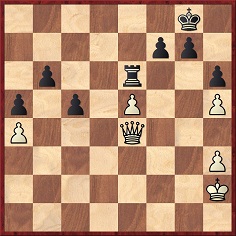
42 Kg3 Kh8 43 Qd5 g6 44 hxg6 Rxg6+ 45 Kf4 Kg7 46 h4 Re6 47 Kf5 Kf8 48 Qd8+ Kg7 49 h5 Rc6 50 Qd7 Re6 51 Qc8 Re7 52 Ke4 Re6 53 Kd5 Re7 54 Qb8 Re6 55 Qd8 c4 56 Qc7 Kf8 57 Qxc4 Re8 58 Qe4 Kg7 59 Kd6 Re6+ 60 Kd7 Kg8 61 Qa8+ Kg7 62 Qb8 Resigns.
Source: Chess Player’s Chronicle, 1848, pages 324-325.
See also Daniel Harrwitz (1821-84)
The feature article includes, from page 395 of Kings, Commoners and Knaves, this remark by Staunton in the Chess Player’s Chronicle, 13 February 1847, page 49:
‘Mr Harrwitz sees everything without the board as well as most players with one.’
Lionel Kieseritzky
Page 219 of the Chess Player’s Chronicle, 1853 described Lionel Kieseritzky as ‘a blindfold player perhaps never surpassed’.George Koltanowski
See Koltanowski.
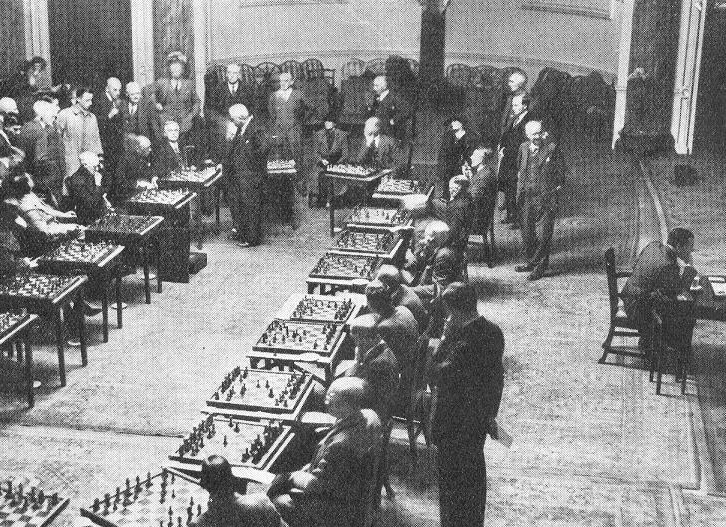
From Chess and Hollywood:

Chess Review, May 1954, page 131
Boris Kostić
Boris Kostić – D. Donaldson
Colorado Springs, July 1915
King’s Gambit Accepted
1 e4 e5 2 f4 exf4 3 Nf3 Bc5 4 d4 Bb6 5 Bxf4 Nf6 6 Nc3 O-O 7 e5 Nh5 8 Bg5 Qe8 9 g4 f6 10 Bc4+ Kh8 11 gxh5 fxg5 12 h6 g6 13 h4 g4 14 Ng5 d6 15 e6 Qc6 16 Bd5 Qe8 17 Qxg4 Qe7 18 O-O-O c6 19 h5 Rf5 20 hxg6 Rxg5 21 g7+ Kg8
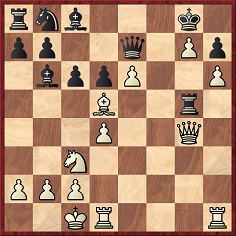
22 Ne4 Rxg4 23 Nf6+ Qxf6 24 e7+ Be6 25 e8(Q)+ and mate next move.
Sources: American Chess Bulletin, September-October 1915, page 195 and The Times Literary Supplement, 26 August 1915, page 288.
The Bulletin commented: ‘One will have to look through Morphy’s collection of games to find anything like this remarkable effort on the part of Boris Kostić.’
(BCM, 1975)
An almost identical note appeared when the game was, to our knowledge, published for the first time, on page 11 of the third section of The Sun (New York), 1 August 1915:

Wanted: information about the simultaneous blindfold game below, published on page 226 of the May 1920 Chess Amateur courtesy of the Morning Post:
Boris Kostić – N.N.
Hastings (date?)
Queen’s Gambit Declined
1 d4 d5 2 c4 e6 3 Nc3 Nf6 4 Bg5 Be7 5 e3 a6 6 Nf3 Nc6 7 Rc1 O-O 8 Bd3 Nh5 9 h4 f6
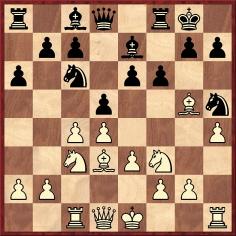
10 Ne5 fxe5 11 Qxh5 e4 12 Nxe4 dxe4 13 Bxe4 g6 14 Bxg6 hxg6 15 Qxg6+ Kh8 16 Rh3 Bf6 17 Rg3 Bxg5 18 hxg5 e5 19 Ke2 Resigns.
The Chess Amateur made no comment on 19 Ke2 or on Black’s decision to resign.
(8617)
Emanuel Lasker
Lasker’s limited interest in blindfold chess was summarized on pages 51-52 of the Hearst/Knott monograph.
James A. Leonard
See James A. Leonard.
Paul Saladin Leonhardt
Paul Saladin Leonhardt (blindfold) – M. Sauter
Frankfurt (date?)
Ruy López
1 e4 e5 2 Nf3 Nc6 3 Bb5 d6 4 d4 exd4 5 Nxd4 Bd7 6 Nc3 Nf6 7 O-O Be7 8 b3 O-O 9 Bb2 Ne5 10 Bxd7 Nfxd7 11 Nd5 Bf6 12 f4 Ng6 13 Qf3 c6 14 Nxf6+ Qxf6 15 Bc3 Qd8 16 Nf5 f6 17 Qg3 Nc5 18 Rae1 Qd7 19 Qg4 Rae8 20 b4 Ne6 21 Re3 c5 22 Rh3 Rf7
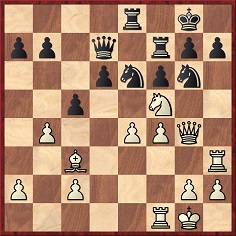
23 Rxh7 Nef8 24 Rh5 Rxe4 25 Rf3 d5 26 Rfh3 d4 27 Rh8+ Nxh8 28 Nh6+ Kh7 29 Nxf7+ Kg8 30 Rxh8+ Kxf7 31 Rxf8+ Ke7 32 Rf7+ Resigns.
Source: Lasker’s Chess Magazine, April 1906, page 271.
Leonhardt’s name is seldom associated with blindfold chess, but a specimen of his play (in a six-board display) can be given from pages 42-43 of Schachjahrbuch für 1910. II. Teil by L. Bachmann (Ansbach, 1911):
Paul Saladin Leonhardt – Oskar Andresen
Kristiania, 6 May 1909
French Defence
1 e4 e6 2 d4 d5 3 Nc3 c5 4 exd5 exd5 5 Nf3 Be6 6 Be2 h6 7 O-O Nf6 8 Be3 c4 9 Ne5 Nc6 10 f4 Ne7 11 g4 g6 12 Rf2 a6 13 Qf1 Rg8 14 Kh1 b5 15 f5 gxf5 16 gxf5 Bc8 17 Qh3 Qc7 18 Bh5 Ng6
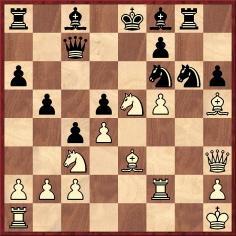
19 fxg6 fxg6 20 Qf3 Nxh5 21 Nxd5 Qb7 22 Nc7+ Qxc7 23 Qxa8 Qb7+ 24 Qxb7 Bxb7+ 25 Kg1 Bd5 26 Raf1 g5 27 Rf5 Be4 28 Rf7 Nf4 29 Bxf4 gxf4+ 30 Kf2 Rg2+ 31 Ke1 Rxc2 32 Rxf8+ Kxf8 33 Rxf4+ Kg8 34 Rxe4 Resigns.
(8430)
Paul Lipke
Paul Lipke’s name is seldom mentioned nowadays in connection with blindfold chess, but Olimpiu G. Urcan (Singapore) has found this feature on page 21 of the Philadelphia Times, 24 March 1895:
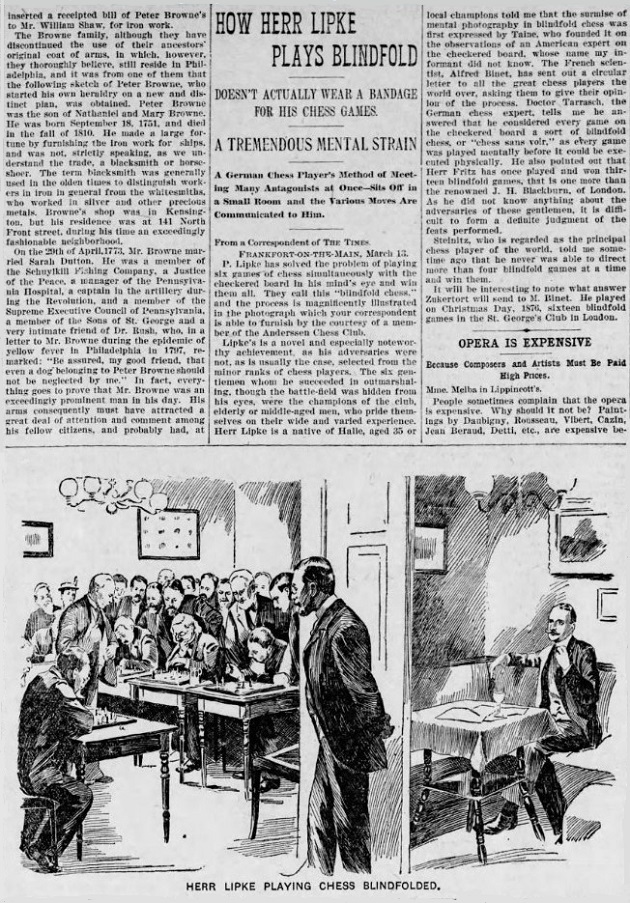
A report on the display was published on page 347 of the November 1894 Deutsche Schachzeitung:
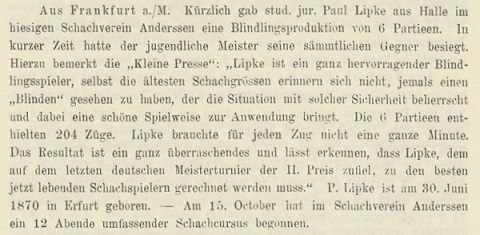
From page 33 of the Chess Monthly, October 1894:
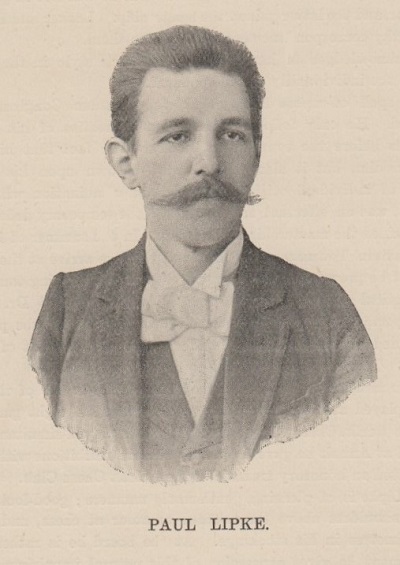
The following page of the magazine stated:
‘Herr Lipke is one of the best living blindfold players. He played at the Berlin Chess Society in 1894 eight games simultaneously, winning all; at the Berlin Chess Club, out of ten games played simultaneously he won nine and drew one; and at Anhalt he gave frequently similar exhibitions with invariable success, so that he was elected an honorary member of the Anhalt Chess Club.’
(9130)

Philadelphia Times, 24 March 1895, page 21
The above report was shown in C.N. 9130, and now we add, courtesy of the Cleveland Public Library, this image:
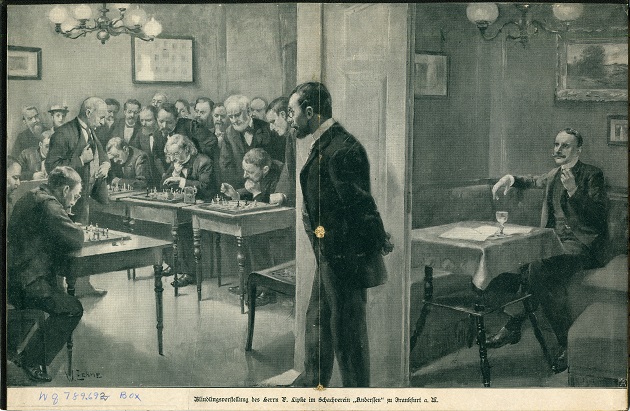
C.N. 9130 had a report on Lipke’s display in Frankfurt from page 347 of the November 1894 Deutsche Schachzeitung, and below is the conclusion of one of his games, against E. Thomas, on page 18 of the January 1899 issue:
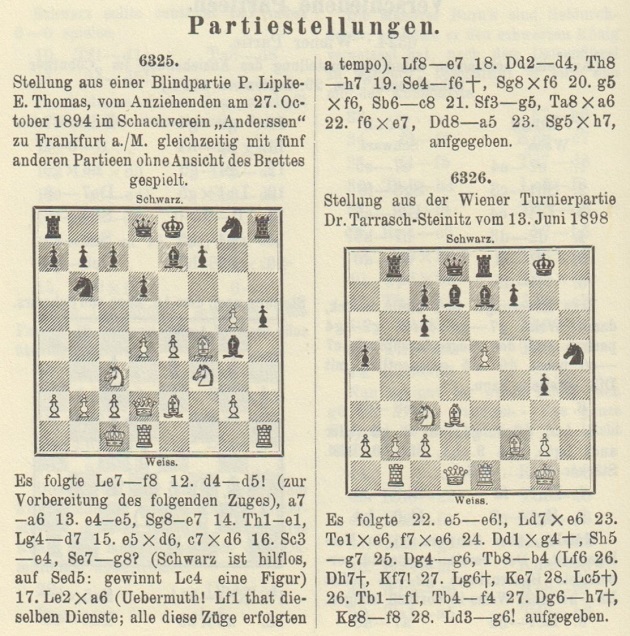
Can more specimens of his blindfold play be found?
A photograph of Lipke was the frontispiece of the January 1900 Deutsche Schachzeitung, and a biographical note on pages 33-34 of the same issue mentioned his ability to play up to ten games simultaneously without sight of the board:
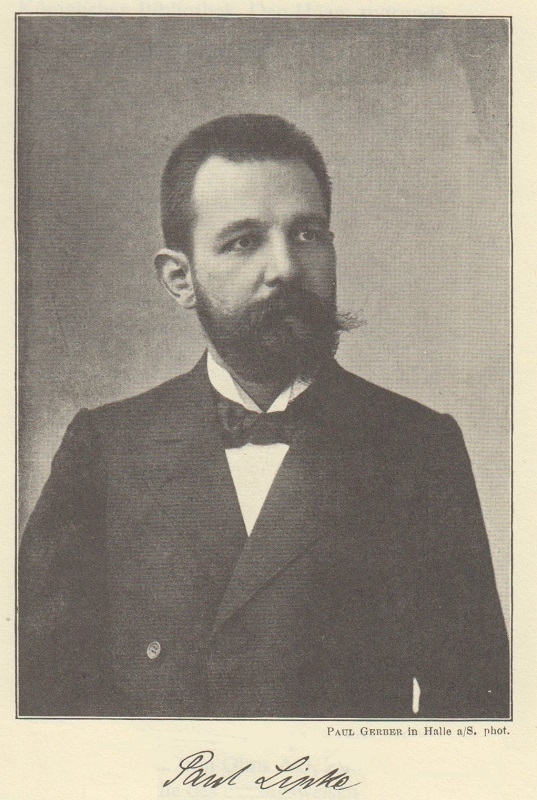
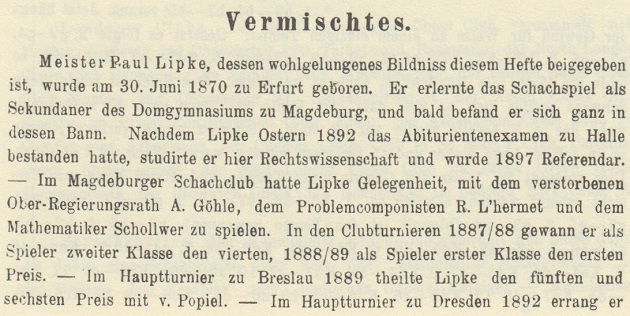
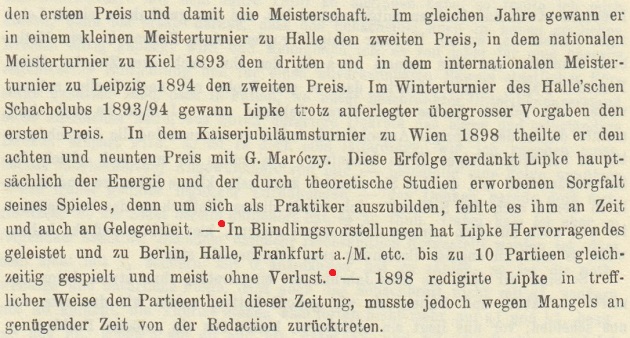
(11538)
Frank James Marshall
Olimpiu G. Urcan submits a cutting from page 18 of the Niagara Falls Gazette of 16 August 1926:
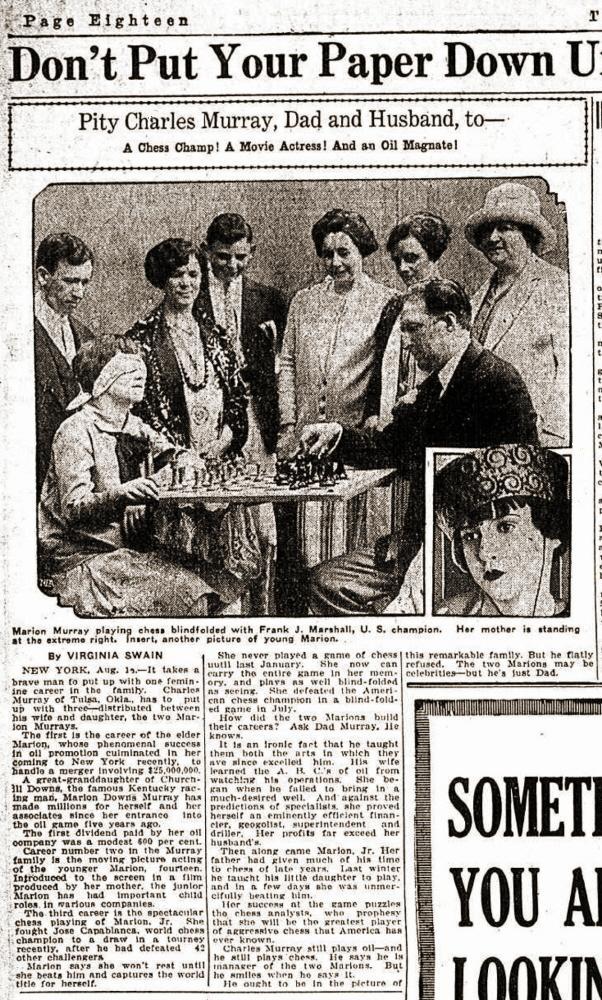
Our correspondent adds:
‘H.R. Bigelow’s column in the New York Evening Post of 30 June 1926 noted that Marion Murray was active at the Marshall Chess Club, playing, for instance, in a rapid transit handicap tournament and winning third prize behind A. Pinkus and C.S. Howell:
“The third prize was won by Miss Marion Murray, aged 12, of Tulsa, Okla. Champion Marshall was impressed by her grasp of the game and remarked afterward that with a little careful coaching she might easily become a serious rival to the present American lady champion, Mrs Natalie Nixdorff”.’
(7070)
Regarding Marshall’s opponent, see too C.N. 6561.
Jacques Mieses
See Jacques Mieses.
Tony Miles
Paul Morphy
Morphy’s blindfold exploits have been well covered in standard monographs on him.
M. Najdorf
We trod gingerly in C.N. 4800 regarding the record for simultaneous chess, and a cautious addition below concerns the largest simultaneous blindfold display whose circumstances are not disputed.
M. Najdorf played 45 games blindfold and simultaneously at the Prestes Maia Gallery, São Paulo, Brazil on 24-25 January 1947. He scored +39 –2 =4 in approximately 23 hours. A report and all 45 game-scores were given on pages 169-179 of Miguel Najdorf El hijo de Caissa by Nicolás Capeika Calvo (Buenos Aires, 2002).
(4811)
Aron Nimzowitsch
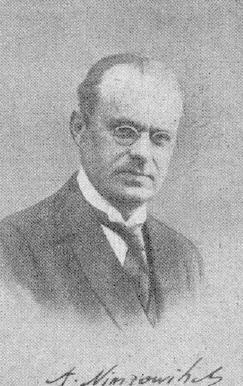
As a companion item to C.N. 4671, which discussed correspondence play by Aron Nimzowitsch, we turn now to his blindfold games. There is the familiar brilliancy against Jokstad, played in Bergen in 1921 and annotated by Nimzowitsch on pages 161-162 of Kagans Neueste Schachnachrichten, 1 April 1925, but how many others are known?
(4685)
Vladimir F. Ostrogsky
From page 154 of Checkmate, May 1904:
‘Moscow possesses a young chessplayer, Ostrogsky by name, who is making a reputation as a blindfold expert. In a recent performance he contested 23 games simultaneously, beating Pillsbury’s record by one. Of course, in strength and rapidity of play he is inferior to the American master, but his chess future is most promising.’
C.N.s 703, 765, 808 and 1467 discussed this little-known player, whose blindfold results were related in various magazines in 1904:
5 (?) November 1903: +5 –1 =3
12 November 1903: +5 –1 =4
5 December 1903: +3 –6 =8
28 February 1904: +8 –5 =7 and three games unfinished.
The allegedly record-breaking 23-game display lasted 14 hours, with a 90-minute break. There were ten opponents in all, some of whom played two or more games against Ostrogsky at the same time.
Sources: Deutsche Schachzeitung, April 1904, page 122. Deutsches Wochenschach, 6 March 1904, page 86 and 20 March 1904, page 103. La Stratégie, 22 February 1904, page 52 and 20 April 1904, page 116. BCM, April 1904, page 168.
The BCM described Ostrogsky as ‘a young player of phenomenal powers in the direction of simultaneous blindfold play’ and gave his 19-move defeat of Rumsha, which is to be found in various databases.
He appeared in the group photograph of Reval, 1904 on page 17 of Baltische Schachblätter, Heft 10, 1905 (scan courtesy of the Cleveland Public Library):
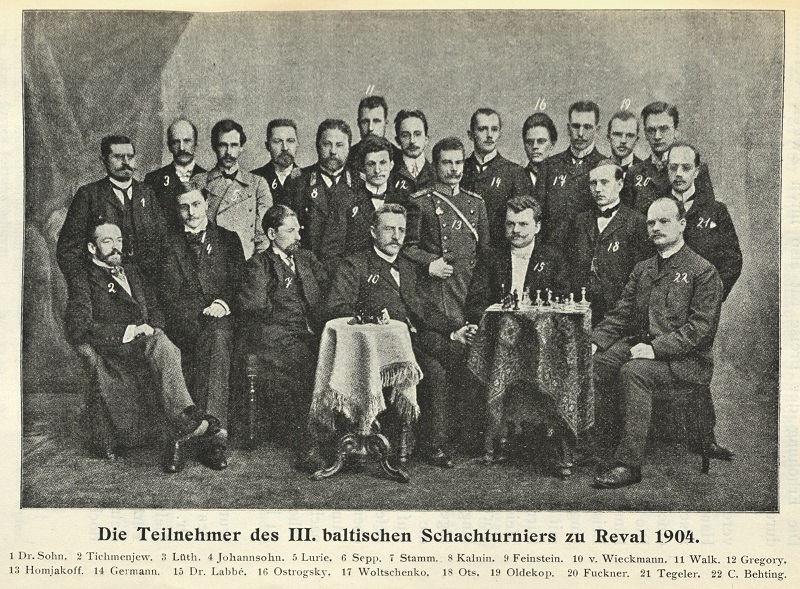
As regards the record which Ostrogsky purportedly beat, it may be recalled that Pillsbury had played 22 games blindfold in Moscow on 14 December 1902, his result being +17 –1 =4. All the game-scores appeared on pages 350-355 of Harry Nelson Pillsbury American Chess Champion by Jacques N. Pope (Ann Arbor, 1996).
(3142)
Patsy A. D’Eramo (North East, MD, USA) has sent us extensive information about Louis Paulsen’s blindfold displays in Pittsburgh in December 1858. Two games are given below, from an exhibition (+6 –4 =0) reported on page 3 of the Pittsburgh Daily Post, 23 December 1858:
Louis Paulsen (blindfold) – Harry Woods
Pittsburgh, 22 December 1858
King’s Gambit Declined
1 e4 e5 2 f4 Bc5 3 Bc4 Nf6 4 fxe5 Nxe4 5 Bxf7+ Kf8 6 Bd5 Qh4+ 7 g3 Bf2+ 8 Kf1 Bxg3 9 Qf3+ Qf4 10 Bxe4 Qxf3+ 11 Nxf3 Bf4 12 Nc3 c6 13 d4 Bxc1 14 Rxc1 Ke7 15 Kg2 Na6 16 Rhf1 d6 17 exd6+ Kxd6 18 Bd3 Be6 19 Rce1 Nb4 20 Ne4+ Kc7 21 Nc5 Bd5 22 Re7+ Kb6 23 Rxb7+ Ka5
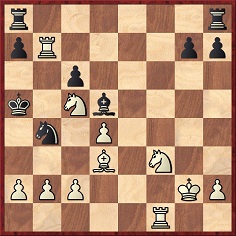
24 a3 Bxf3+ 25 Rxf3 Resigns.
Source: Pittsburgh Gazette, 24 December 1858, page 3.
Louis Paulsen (blindfold) – C. Von Bonnhorst
Pittsburgh, 22 December 1858
Irregular Opening
1 e4 d6 2 d4 c6 3 Nf3 Bg4 4 Nc3 e6 5 Be2 Be7 6 O-O Bxf3 7 Bxf3 Nf6 8 b3 Nbd7 9 Bb2 e5 10 Ne2 O-O 11 c4 b6 12 Qc2 c5 13 d5 Kh8 14 Ng3 Ng8 15 Be2 Nh6 16 f4 a5 17 fxe5 Nxe5 18 Rad1 f6 19 Nh5 Qe8 20 Nf4 Rc8 21 Ne6 Rg8 22 Qc3 Nd7 23 Qh3 Nf8 24 Bh5 Nf7 25 Rf4 Nxe6 26 dxe6 Ng5 27 Qh4 Qf8 28 Rdf1 Nxe6
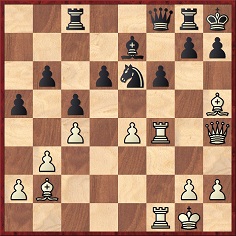
29 Bg6 Ng5 30 Rf5 h6 31 Rxg5 Bd8 32 Rgf5 Rc7
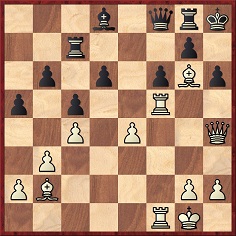
33 Rxf6 gxf6 34 Rxf6 Bxf6 35 Bxf6+ Rgg7 36 Qxh6+ Kg8 37 Bf5 Rxg2+ 38 Kxg2 Qxh6 39 White resigns.
Source: Pittsburgh Gazette, 24 December 1858, page 3.
(9923)
Regarding a Paulsen v Morphy blindfold game see C.N. 11562.
François-André Danican Philidor
See François-André Danican Philidor.
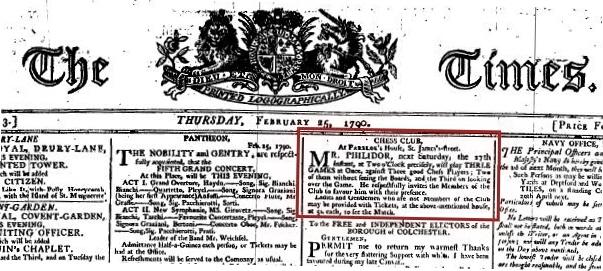

Harry Nelson Pillsbury
See Harry Nelson Pillsbury and Pillsbury’s Torment.
Polgár sisters
The following game was played at the television studios of DRS (Swiss German Television) during the 1987 Biel tournament. Both prodigies played blindfold and had five minutes for all their moves.
Judit Polgár – Sofia Polgár
Sicilian Defence
1 e4 c5 2 Nf3 Nc6 3 Bb5 g6 4 O-O Bg7 5 c3 Nf6 6 d4 cxd4 7 cxd4 O-O 8 d5 Nb8 9 e5 Ne8 10 Nc3 d6 11 Bf4 a6 12 Bxe8 Rxe8 13 Re1 dxe5 14 Bxe5 Bxe5 15 Nxe5 Bf5 16 Qf3 Nd7 17 Nxf7 Kxf7 18 g4 Nf6 19 gxf5 Rg8 20 Kh1 Qd7 21 Re6 Rad8 22 Rae1 g5 23 Ne4 Qxd5 24 Qc3 and Black lost on time.
This game has not, to our knowledge, been published elsewhere.
(1594)
Cecil John Seddon Purdy
Blindfold games by C.J.S. Purdy are scarce, but one can be given here, from pages 257-258 of the 10 September 1936 issue of the Australasian Chess Review. It was played during his tour of New Zealand, in a six-board blindfold exhibition. As we do not have a complete run of the magazine in the mid-1930s, any further details which may have been published in another issue will be appreciated.
Cecil John Seddon Purdy (blindfold) – W.H. Joyce
Christchurch (date?)
‘Caro-Kann (in effect)’
1 d4 e6 2 c4 Nf6 3 Nc3 c6 4 e4 d5 5 e5 Nfd7 6 cxd5 cxd5 7 Nf3 a6 8 a4 Bb4 9 Bd3 Qc7 10 O-O Bxc3 11 bxc3 Qxc3 12 Ba3 Qa5 13 Qb3 Nc6 14 Rfc1 Qd8 15 Bd6 Qb6 16 Qa3 g6 17 Rab1 Qa7 18 a5 f5
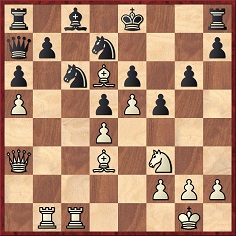
19 Bc2 Nxd4 20 Nxd4 Qxd4 21 Ba4 h6 22 Rc7 Qh4 23 Rbxb7 Qd8 24 Bxd7+ Bxd7 25 Rxd7 Qxd7 26 Rxd7 Kxd7 27 Be7 Rhb8 28 h4 Rb7 29 Qd6+ Kc8 30 Qd8 mate.
(9724)
Eduardo Bauzá Mercére (New York, NY, USA) reports that the blindfold game in Christchurch between Purdy and Joyce given in C.N. 9724 was played on 13 January 1936 and that a report was published on page 13 of the Christchurch Press the following day. Extensive information about Purdy’s 1935-36 tour of New Zealand is available via the website of the National Library of New Zealand, and our correspondent has sent this summary:
‘Auckland:
11 December (afternoon): blindfold simultaneous exhibition +2 –1 =3 (New Zealand Herald, 12 December 1935, page 14);
11 December (evening): simultaneous exhibition +17 –4 =10 (New Zealand Herald, 12 December 1935, page 14);
Hamilton:
12 December: simultaneous exhibition +22 –2 =4 (New Zealand Herald, 14 December 1935, page 17);
13 December: blindfold simultaneous exhibition +6 –0 =0 (New Zealand Herald, 16 December 1935, page 12);
13 December: consultation game against Hamilton team; Purdy won in 20 moves (New Zealand Herald, 16 December 1935, page 12);
Auckland:
18 December: simultaneous exhibition +16 –1 =1 (New Zealand Herald, 19 December 1935, page 12);
Tauranga:
23 December: blindfold simultaneous exhibition +4 –0 =3 (New Zealand Herald, 24 December 1935, page 12);
Wellington:
26 December to 6 January: New Zealand championship. Purdy was entitled to win any of the prizes, but not the New Zealand title, as he was born in Egypt and had not been a resident of the Dominion during the previous six months (Wellington Evening Post, 24 December 1935, page 16). Leading final scores: 1 Purdy, 12/13 (lost to Gyles); 2 A.W. Gyles 11 (won the championship), 3-4 Ian Burry and D.I. Jones, 8½; 5 J.A. Erskine 8.
7 January (afternoon): blindfold simultaneous exhibition +2 –0 =4 (draw with Joyce); (Wellington Evening Post, 8 January 1936, page 11);
7 January (evening): simultaneous exhibition +13 –2 =4;
8 January (afternoon): first match-game with Gyles (adjourned);
8 January (evening): simultaneous exhibition +20 –1 =5;
9 January (afternoon): won the adjourned game and the second game with Gyles; (evening) simultaneous exhibition +9 –1 =2;
Christchurch:
11 January (afternoon): Purdy-W.D. Khoury 1-0 (first match-game) (Christchurch Press, 13 January 1936, page 10);
11 January: simultaneous exhibition +17 –2 =5 (Christchurch Press, 13 January 1936, page 10);
13 January: blindfold simultaneous exhibition +4 –1 =1 (Christchurch Press, 14 January 1936, page 13);
14 January: W.D. Khoury-Purdy (second match-game?);
15 January (afternoon): Purdy-W.D. Khoury 1-0 (third match-game); (Christchurch Press, 15 January 1936, page 15);
15 January (evening): simultaneous exhibition +14 –3 =6 (Christchurch Press, 15 January 1936, page 15).’
Mr Bauzá Mercére adds that although no game-scores have been found, two photographs from the tour can be shown:
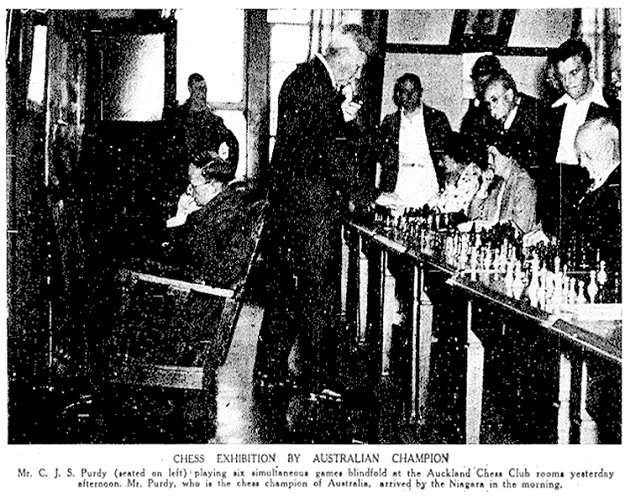
New Zealand Herald, 12 December 1935, page 10
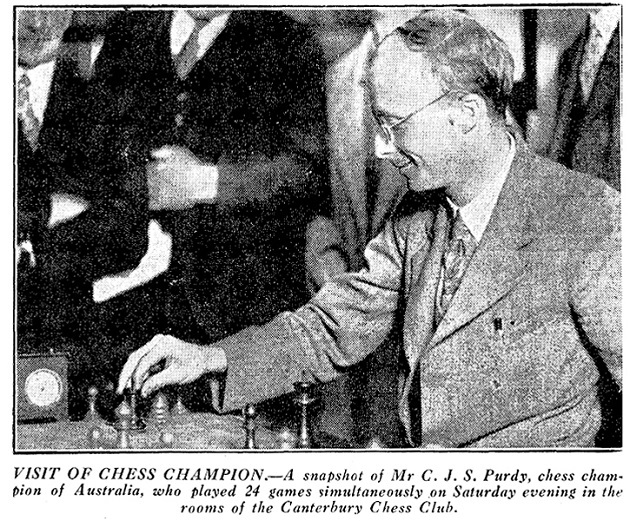
Christchurch Press, 13 January 1936, page 16.
(9735)
Birdie Reeve
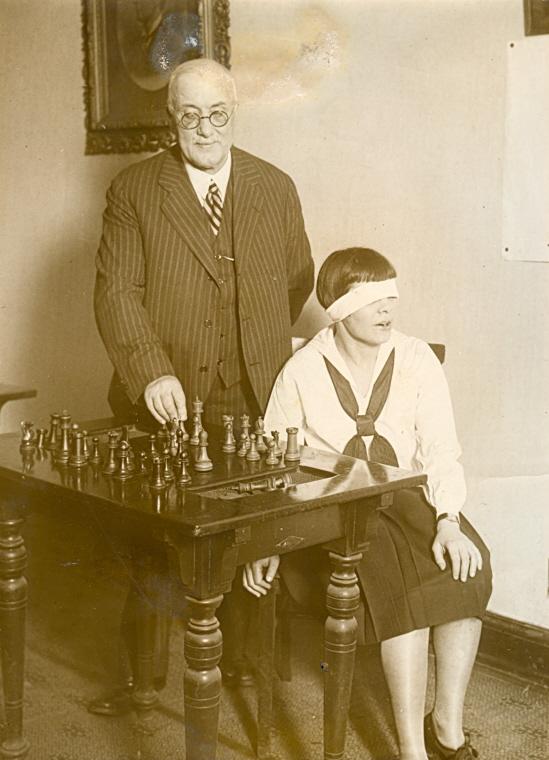
Richard Réti
An excerpt from Rudolph Réti’s essay on his brother:
‘Included as a regular feature in all his tours, besides lectures and courses, were exhibitions of simultaneous games of the so-called “blindfold” type. In playing blindfold, Richard had exceptional facility. He once gave an exhibition of 29 games simultaneously played in this manner – just because, he jokingly said, no more good players were then available in the club. These 29 “blind” games constituted a world record at that time.
When playing blindfold, the player, as is well known, sits throughout the contest in the center of the hall, without seeing any of the chessboards at which his opponents are placed. Although the performance usually makes a strong impression on the spectators, Richard did not consider these exhibitions as much of an achievement. “They require just some practise”, he declared, and went on to explain that in these “blind” games one does not try – or at least he did not try – to see the actual position of the game on the board in his mind, although he could have done so at any moment, had he so wished. One simply plays, he contended, according to a kind of “instinctive memory”, knowing which combination or plan is in progress in each single game. The main difficulty comes at the beginning of the performance, when one must follow a pre-planned system of how the first five games will be opened, then the next five, and so on, in order not to confuse one game with another. After the first five or ten moves, each game assumes its own individual character, and then the distinction between them is easy and, as it were, takes place of itself. For those like the present writer, to whom this explanation is hardly self-evident or simple, still more elaborate explanations would scarcely prove more enlightening.’
Comments by Capablanca on page 10 of The Times, 29 July 1922:
‘Réti has an exceedingly well-balanced style of play; possesses a thorough knowledge of the game in all its departments, and if he had the confidence and energy of the other two he might be the strongest candidate of the four. He has not had, so far, the success to which I think his play entitles him. He has of late devoted considerable time to blindfold playing on a large scale – that is, he has often played 20 games or more simultaneously without sight of board or men. Such displays may excite wonder among a large number of chess enthusiasts, but as far as the performer is concerned they do him a great deal of harm in the long run. It gets him into the habit of playing a certain kind of game, not at all like what he is called upon to produce when facing opponents of the class he is bound to meet in international contests. I would not be surprised if it is his blindfold playing that has been the cause of his relative failure in the last two years.’
For the full article by the Cuban, see Capablanca on London, 1922.
Samuel Reshevsky
Horacio Paletta (Buenos Aires) notes that this photograph appeared on page 36 of the February 1949 Chess Review:
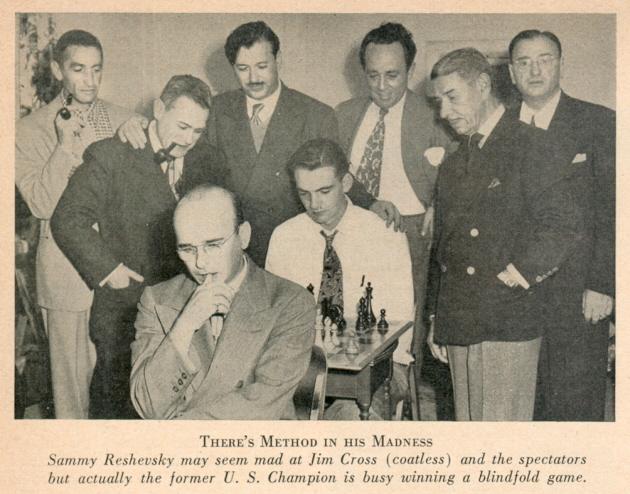
Ramón Rey Ardid
From pages 181-182 of Los principios del ajedrez by Ramón Rey Ardid (Saragossa, 1939):
Ramón Rey Ardid (blindfold) – N.N.
Venue?, 1939
King’s Fianchetto Defence
1 e4 g6 2 d4 Bg7 3 f4 e6 4 Nf3 Ne7 5 Be2 O-O 6 Be3 c5 7 c3 cxd4 8 cxd4 Nec6 9 Nc3 Qb6 10 Qd2 Qb4 11 g4 f5 12 gxf5 exf5 13 a3 Qb3 14 e5 Na6 15 d5 Ne7 16 Nd4 Qb6 17 Nc6 Qc7 18 Nb5 Resigns.
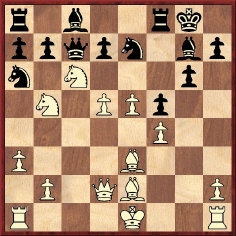
Samuel Rosenthal
See A Forgotten Showman.
Friedrich (Fritz) Sämisch
A widely-published blindfold game won by F. Sämisch against N.N.:
1 e4 e6 2 d4 d5 3 Nc3 Bb4 4 e5 c5 5 Bd2 cxd4 6 Nb5 Bc5 7 b4 Bb6 8 Qg4 Kf8 9 Nf3 Nc6 10 Qf4 f6 11 exf6 Qxf6 12 Nc7 Bxc7 13 Qxc7 h6 14 b5 d3
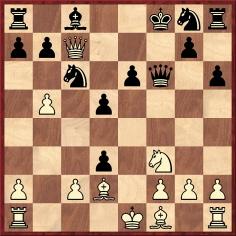
15 Bxd3 Qxa1+ 16 Ke2 Qf6 17 bxc6 Qe7 18 Bb4 Qxb4 19 Qd8+ Kf7 20 Ne5 mate.
Wanted regarding this game-score: the oldest possible citations from magazines and columns of the time. But when was ‘the time’? ‘Aachen, 1943’ was the heading when the game was published on pages 174-175 of The Joys of Chess by Fred Reinfeld (New York, 1961), but other books tend to give the date as 1934. See, for instance, pages 363-364 of Irving Chernev’s Best Short Games collection, which introduced the game as follows:
‘“Of all the modern masters that I have had occasion to observe playing blindfold chess, it is Sämisch who interests me the most; his great technique, his speed and precision have always made a profound impression on me.” So said Alekhine, himself one of the most magnificent exponents of the art.’
Alekhine made the remark on page 19 of Auf dem Wege zur Weltmeisterschaft (Berlin and Leipzig, 1932):
‘Von allen modernen Meistern, die ich beim Blindspiel zu beobachten Gelegenheit hatte, gefiel mir Sämisch am besten; seine große Technik, seine Schnelligkeit und Sicherheit haben mir imponiert.’
The French version, from page 270 of Deux cents parties d’échecs (Rouen, 1936):
‘De tous les Maîtres modernes que j’ai eu l’occasion d’observer au jeu à l’aveugle, c’est Sämisch qui m’intéresse le plus; sa grande technique, sa rapidité et sa sûreté m’ont toujours fait une profonde impression.’
(7683)
Peter Anderberg (Harmstorf, Germany), Hans-Georg Kleinhenz (Munich, Germany) and Alan McGowan (Waterloo, Ontario, Canada) note that the game was published on page 304 of Deutsche Schachblätter, 1 October 1934:
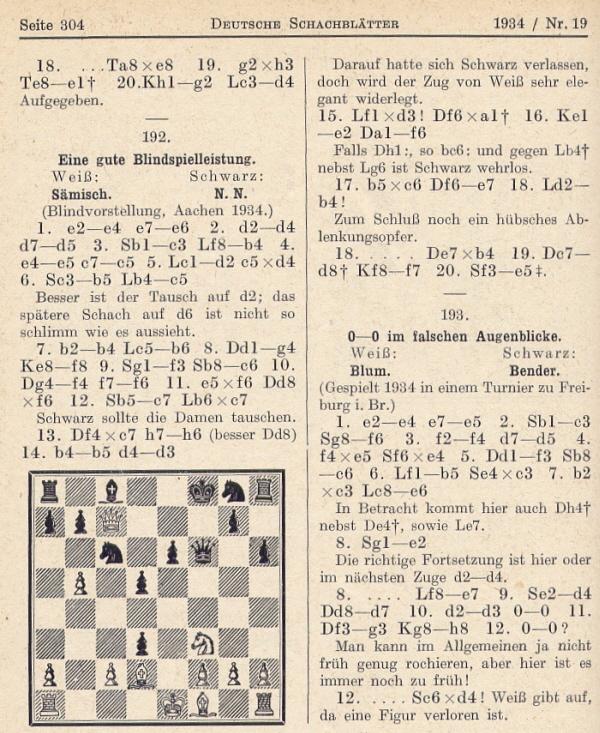
The display, which took place in Aachen on 28 May, was mentioned on page 190 of the 15 June 1934 issue, with the information that Sämisch won all ten blindfold games within five hours:

Mr Kleinhenz adds:
‘The handwritten chronicle of the Aachener Schachverein 1856 (the organizer of the German Championship) does not contain a detailed report of the exhibition but mentions that some were consultation games:
“Saemisch spielt anl. der Dt. Meisterschaft an 10 Brettern blind. Zum Teil Beratungspartien. S. gewinnt alle Partien.”’
Furthermore, Mr Anderberg notes that the game-score was published in Chemnitzer Wochenschach, 10 June 1934:
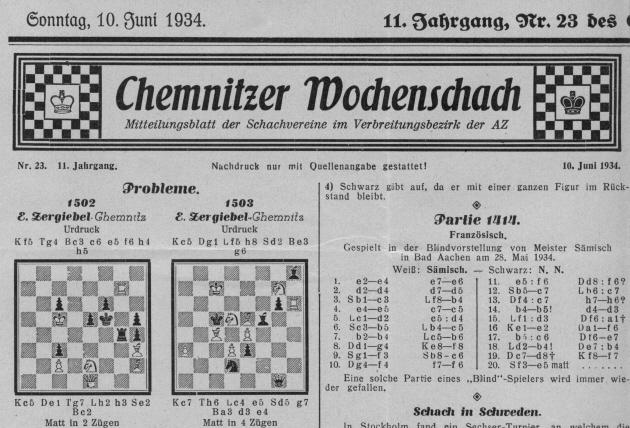
(7690)
1 e4 c5 2 Nf3 d6 3 Bb5+ Bd7 4 Bxd7+ Qxd7 5 O-O Nc6 6 d4 cxd4 7 Nxd4 e6 8 c4 Nf6 9 Nc3 Be7 10 b3 O-O 11 Bb2 Rfd8 12 Qd2 Ne8 13 Rad1 a6 14 Nc2 Qc7 15 Ne3 Qb8 16 Qe2 b5 17 Rd2 Ne5 18 f4 Ng6 19 Qf2 Qb6 20 f5 Bg5
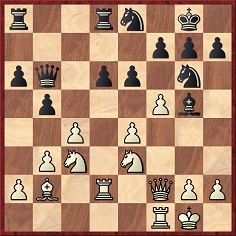
21 Ncd5 exd5 22 Bd4 Qb7 23 fxg6 hxg6 24 Nxd5 Bxd2 25 Qxd2 Rab8 26 Qg5 Rd7 27 Rf3 bxc4 28 Rh3 cxb3
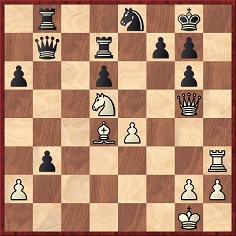
29 Nf6+ Nxf6 30 Qxf6 gxf6 31 Bxf6 Resigns.
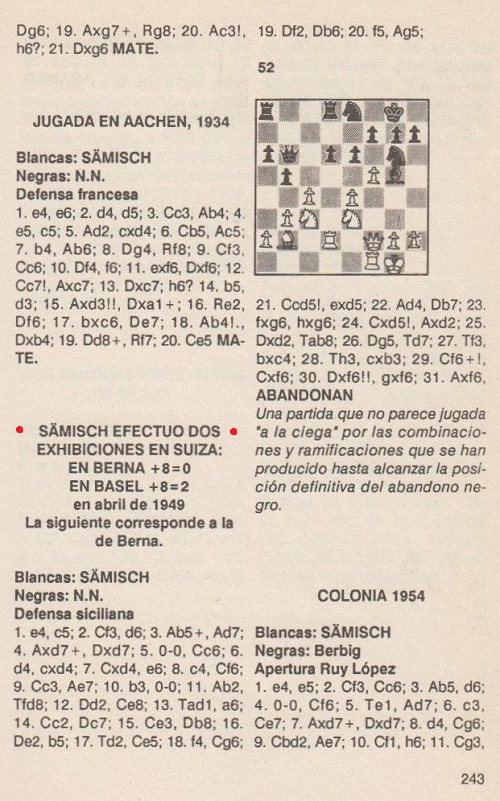
The above is page 243 of Ajedrez a la ciega by Benito López Esnaola (Madrid, 1989); see too page 385 of Blindfold Chess by Eliot Hearst and John Knott (Jefferson, 2009). The reference in the game heading to April 1949 is incorrect, as shown below.
The score was not published in the main Swiss chess periodical of the time, the Schweizerische Schachzeitung, although page 110 of the July 1949 issue had a brief report on Sämisch’s display in Berne:

Richard Forster (Zurich) has forwarded us two chess columns by Erwin Voellmy in the Basler Nachrichten, the first dated 29 January 1949:
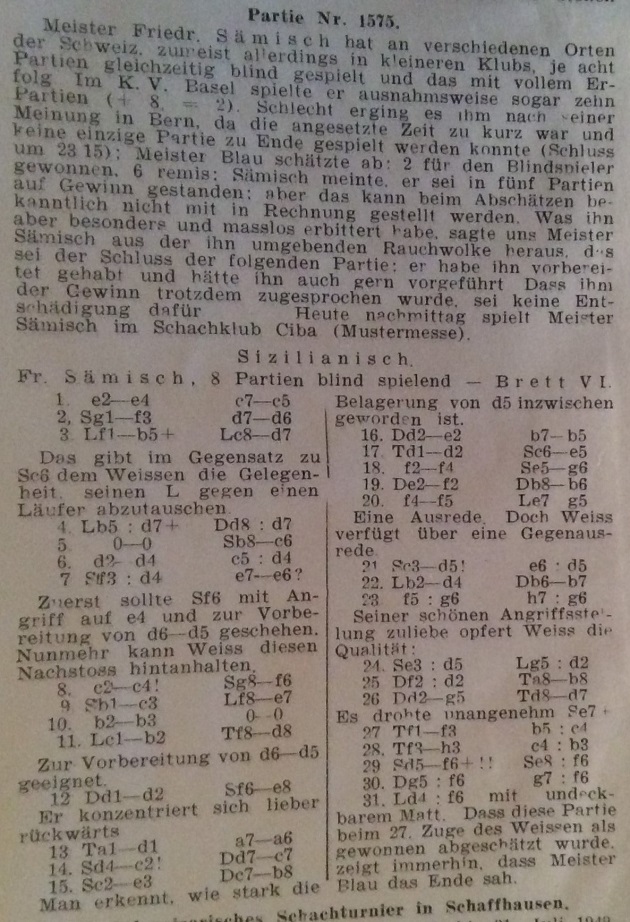
Thus, owing to the late hour Sämisch had no opportunity to play the combinative finish against his unidentified opponent. The game was adjudicated at move 27 (after Rf3).
The second column (Basler Nachrichten, 5 February 1949) had a small correction concerning the number of games broken off:
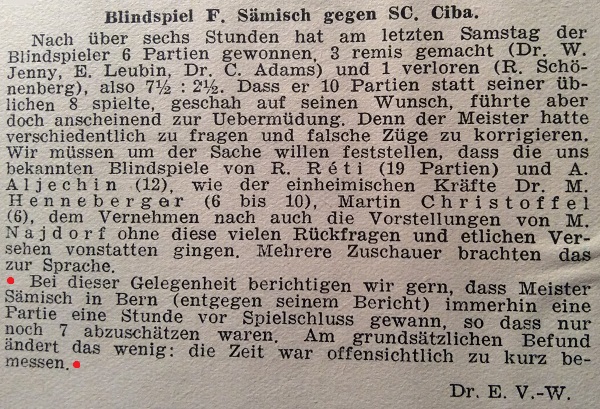
The brilliancy can be found in a number of publications with Black identified as Koller. For instance, it is game 25 in 60 champions ... 60 parties by Alain Benlolo (Nice, 1992), a booklet subtitled ‘les plus belles parties d’échecs de tous les temps’. Certainly there was a player in Berne named Koller – in another context he was mentioned, for example, on page 45 of the March 1949 issue of the Schweizerische Schachzeitung – but when was the name Koller first attached to the Sämisch game?
(9373)
From Max Euwe’s ‘Game of the Month’ column on pages 74-75 of Chess Review, March 1952:
‘Masters of the future may differ from the older ones in paying less attention to material advantages. In this connection, Sämisch has made one of the most telling comments I have ever encountered on the subject: he remarks that he finds it easier to sacrifice in a blindfold game than in a regular game – because in a blindfold game he finds it easier to ignore purely material considerations.’
(10276)
From Hans Frank and Chess:
The following game, from a ten-game blindfold exhibition by Sämisch, was published on pages 87-88 of Deutsche Schachblätter, 15 March 1936, with annotations by White:
Friedrich Sämisch – Hans Frank
Berlin, 2 March 1936
Giuoco Piano1 e4 e5 2 Nf3 Nc6 3 Bc4 Nf6 4 d3 Bc5 5 Nc3 d6 6 Be3 Bb6 7 Qd2 h6 8 Nd5 Be6 9 Nxf6+ Qxf6 10 Bxe6 Qxe6 11 Bxb6 axb6 12 a3 O-O 13 O-O f5 14 Qe2 f4 15 c3 g5 16 Ne1 g4 17 f3 h5 18 Kh1 Kf7 19 Nc2 Rg8 20 Rae1 Qf6 21 Nb4 Ne7 22 Nd5 Nxd5 23 exd5 Raf8 24 c4 Rg7 25 d4 Rg5 26 dxe5 Rxe5 27 Qd2 Rxe1 28 Rxe1 Re8 29 Rxe8 Kxe8 30 Qe2+ and Sämisch’s offer of a draw was accepted by the Reichsminister.
Ortvin Sarapu
From page 242 of Chess World, November 1952, the writer being C.J.S. Purdy:
‘Sarapu thinks nothing of playing lightning chess at five seconds a move – his opponent seeing the board. Besides Sarapu, Reuben Fine and George Koltanowski are the only players I have heard of who play lightning chess blindfold, but as far as I know they have only played at ten seconds. Dawdlers!’
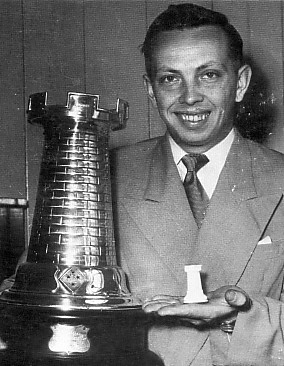
Ortvin Sarapu
(3444)
Courtesy of Val Zemitis, John Donaldson (Berkeley, CA, USA) has forwarded this photograph of Ortvin Sarapu playing blindfold chess:
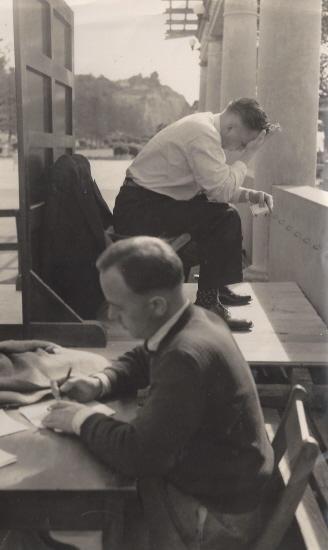
The picture was by Russell Orr of Hastings, New Zealand. The writing on the reverse side states that it was taken in Napier, New Zealand at Easter 1954.
(7559)
Elaine Saunders
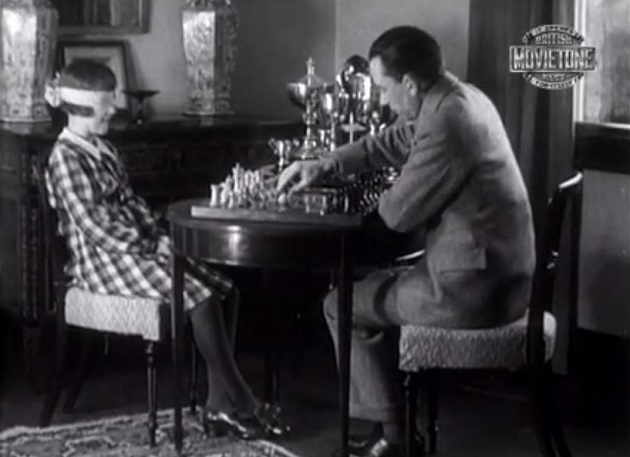
See The Chess Prodigy Elaine Saunders.
Carl Schlechter
From page 190 of the December 1898 Wiener Schachzeitung:

This photograph is on page 8 of Das interessante Blatt, 22 December 1898:
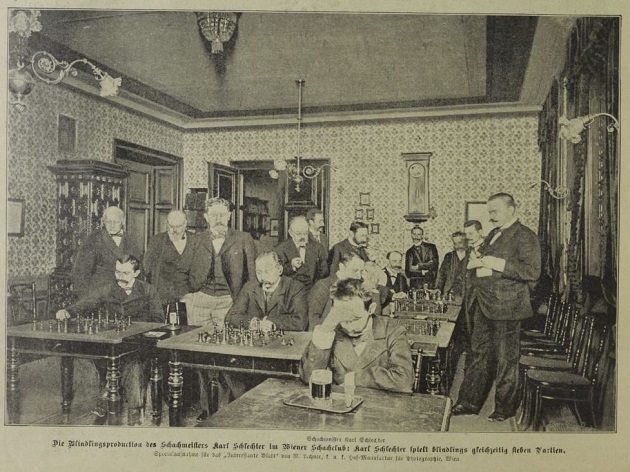
(11320)
Daniel Starbuck
See Daniel Starbuck (1856-84).
Wilhelm Steinitz
‘Steinitz played Jack the Ripper’
The lurid headline above could, just possibly, be true. The Ripper & The Royals by Melvyn Fairclough (London, 1991) set out to demonstrate that Jack the Ripper was Winston Churchill’s father, Lord Randolph Churchill (1849-95). From page 89:
‘He further proved his ability to plot ahead when he became a first-class chess player. He once played against the chess champion of the world in a game described by Winston as ‘original, daring, and sometimes brilliant’.
The score is to be found on page 257 of part 1 of Schachmeister Steinitz by Ludwig Bachmann (Ansbach, 1910):
Wilhelm Steinitz (blindfold, simultaneous) – Lord Randolph
Churchill
Oxford, 17 May 1870
King’s Gambit Accepted
1 e4 e5 2 f4 exf4 3 Nf3 g5 4 h4 g4 5 Ne5 Qe7 6 d4 d6 7 Nxg4 Qxe4+ 8 Qe2 d5 9 Ne5 Nh6 l0 Nc3 Bb4 11 Qxe4 dxe4 12 8xf4 Nf5 13 O-O-O Bxc3 14 bxc3 Nd6 15 c4 f6 16 c5 fxe5 17 Bxe5 Nf7 18 Bxh8 Nxh8 19 Re1 b6 20 Rxe4+ Kd8 21 Bc4 Bb7 22 Rg4 Ng6 23 h5 Ne7 24 Re1 Nbc6 25 d5 Nb4 26 c6 Bc8 27 Rg7 Nbxc6 28 dxc6 Nxc6 29 Bb5 Bb7 30 Rd1+ Ke8 31Rxc7 Kf8 32 Rf1+ Kg8 33 Bc4+ and Black is mated in a few moves.
Bachmann also gives (pages 258-259) a drawn consultation game, played in Oxford in August 1870, between Steinitz and Anthony, Churchill and Ranken.
Steinitz himself wrote an admiring sketch of Lord Randolph Churchill (and another parliamentarian, Charles Bradlaugh) in the New York Tribune of 4 February 1891, a text subsequently reprinted on pages 4-6 of the January 1891 issue of the International Chess Magazine. The obituary of Lord Randolph Churchill on page 82 of the February 1895 BCM reported that from his early college days to the beginning of his political career the deceased was, in his own words, ‘an ardent chessplayer’. Further information, including details of Winston Churchill’s enthusiasm for chess, is given on pages 89-90 of King, Queen and Knight by Norman Knight and Will Guy (London, 1975).
This is hardly the place for a discussion of the claim that Lord Randolph Churchill perpetrated the Whitechapel murders of 1888. It need merely be stressed that countless Victorian notables have been accused of involvement by one ‘Ripperologist’ or another.
(Kingpin, 1993)
A footnote on page 314 of Kings, Commoners and Knaves:
Steinitz suggested ironically that the chessplayer and poet Wordsworth Donisthorpe could have been Jack the Ripper. See, in particular, the following issues of the International Chess Magazine: October 1889, page 298; November 1889, pages 333-334; December 1889, page 370; January 1890, page 11.
A feature on page 107 of the April 1885 issue of the International Chess Magazine:
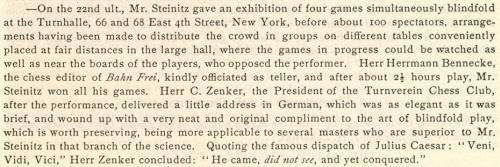
(6539)
With respect to the last sentence (and the claim of originality), we now note a report on page 154 of the Westminster Papers, 1 December 1873:
‘Mr Blackburne’s blindfold performance was on this, as on previous occasions, an unqualified success. Against ten opponents he won six games, drew three and lost but one, after a contest of over eight hours. He came, he did not see, but he conquered.’
(7616)
Savielly Tartakower
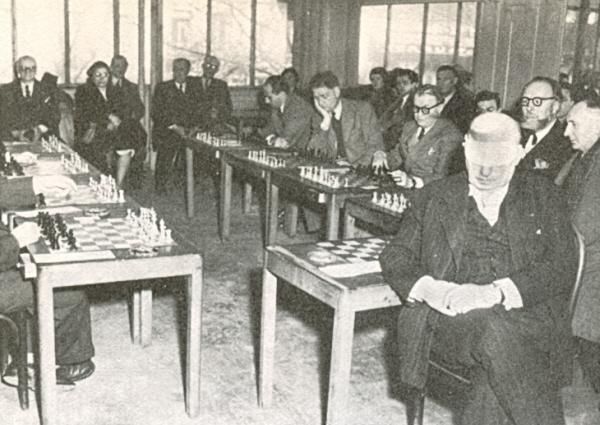
This photograph comes from page 92 of Objectif mat! by R. Bertolo and L. Risacher (Paris, 1978). Is any information available about the occasion?
(6562)
Olimpiu G. Urcan has forwarded the following from page 408 of the Illustrated London News, 14 March 1953:
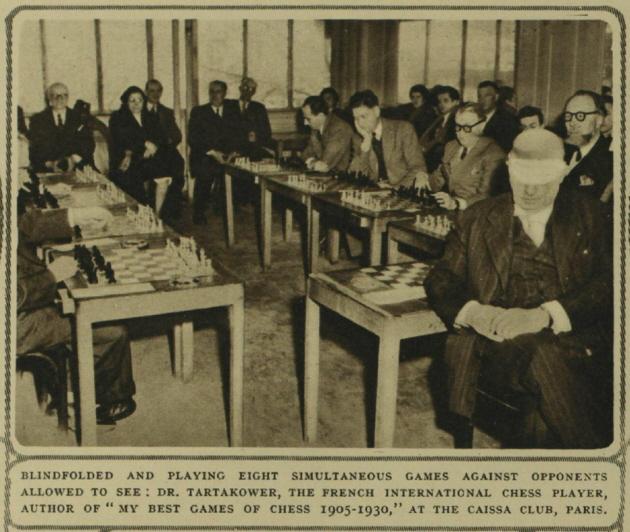
(7503)
From page 118 of La Stratégie, May 1924:
‘Paris. A son retour du Tournoi de New York, le maître Tartakover donne deux séances de chacune 10 parties sans voir: l’une aux Echecs du Palais-Royal le dimanche 7 mai, avec le résultat de 7 gagnées et 3 nulles; l’autre le mercredi suivant au Cercle Philidor avec le résultat de 9 gagnées et 1 nulle.’
There remains doubt about the dates of both séances, as 7 May 1924 was a Wednesday, and not a Sunday.
No game-scores were given by La Stratégie, and blindfold games by Tartakower are scarce. However, the draw in the second display was published, courtesy of his opponent, on page A3 of the Brooklyn Daily Eagle, 12 June 1924:
Savielly Tartakower (blindfold) – Reuben Goldsmith
Paris, May 1924
Scotch Game
1 e4 e5 2 Nf3 Nc6 3 d4 exd4 4 Nxd4 Bc5 5 Be3 Qf6 6 c3 Nge7 7 Nc2 Bxe3 8 Nxe3 d6 9 Nd2 O-O 10 Be2 Ne5 11 O-O N5g6 12 g3 Bh3 13 Ng2 Qe5 14 f4 Qc5+ 15 Rf2 Bxg2 16 Kxg2 f5 17 Bf3 Kh8 18 Qc2 fxe4 19 Nxe4 Qb6 20 h4 Nf5
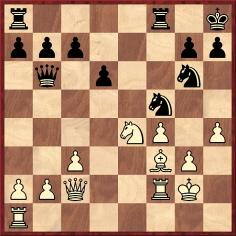
21 Re1 Ne3+ 22 Rxe3 Qxe3 23 Re2 Qb6 24 Ng5 Rf6 25 h5 Nf8 26 Bd5 c6 27 Nf7+ Kg8 28 Nh6+ Kh8 29 Nf7+ Kg8 Drawn.
(8118)
C.N. 8118 mentioned the rarity of blindfold games played by Tartakower. Below is a specimen (from a five-board display) published on page 138 of Schachjahrbuch für 1909 by Ludwig Bachmann (Ansbach, 1909):
Savielly Tartakower – Häusler
Augsburg, 14 September 1909
Queen’s Gambit Declined
1 d4 d5 2 c4 e6 3 Nc3 c5 4 cxd5 exd5 5 e4 dxe4 6 d5 Bf5 7 g4 Bg6 8 Bf4 Bd6 9 Qa4+ Kf8 10 Bxd6+ Qxd6 11 O-O-O Qf4+ 12 Rd2 Nf6 13 h4 h5 14 Nh3 Qxg4 15 Rg1 Qd7 16 Qc4 Na6
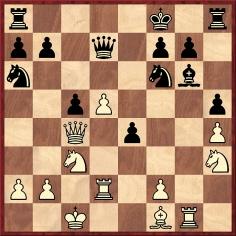
17 Rxg6 fxg6 18 Ng5 Re8 19 Bh3 Ng4 20 Ne6+ Kg8 21 Qxe4 Qf7 22 f3 Nf6 23 Qc4 Nc7 24 Ng5 Re1+ 25 Kc2 b5 26 Nxf7 (The Schachjahrbuch does not mention the possibility of 26 Qxc5.) 26...bxc4 27 Nxh8 Kxh8 28 d6 Na6 29 a3 Re8 30 d7 Rd8 31 Ne4 Nxe4 32 fxe4 Kg8 33 e5 Kf8 34 e6 Nc7 35 Rf2+ Ke7 36 Rf7+ Kd6 37 e7 Rxd7 38 e8(Q) Nxe8 39 Rxd7+ Ke5 40 Re7+ Resigns.
(8418)
See also Savielly Tartakower.
Paul Rudolf von Bilguer
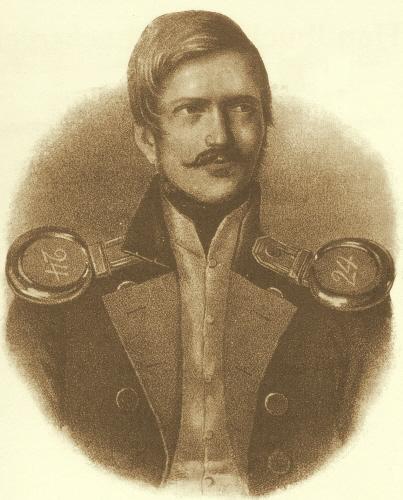
Andreas Lange (Berlin) refers to three games played by Paul Rudolf von Bilguer simultaneously (two of them blindfold) in Berlin on 19 March 1840 and published on pages 91-93 of the March 1852 Deutsche Schachzeitung:
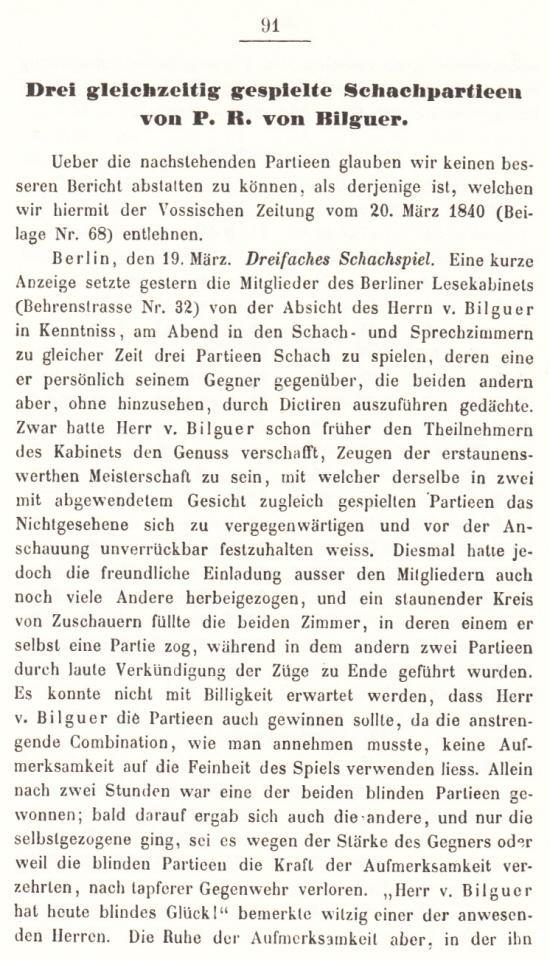
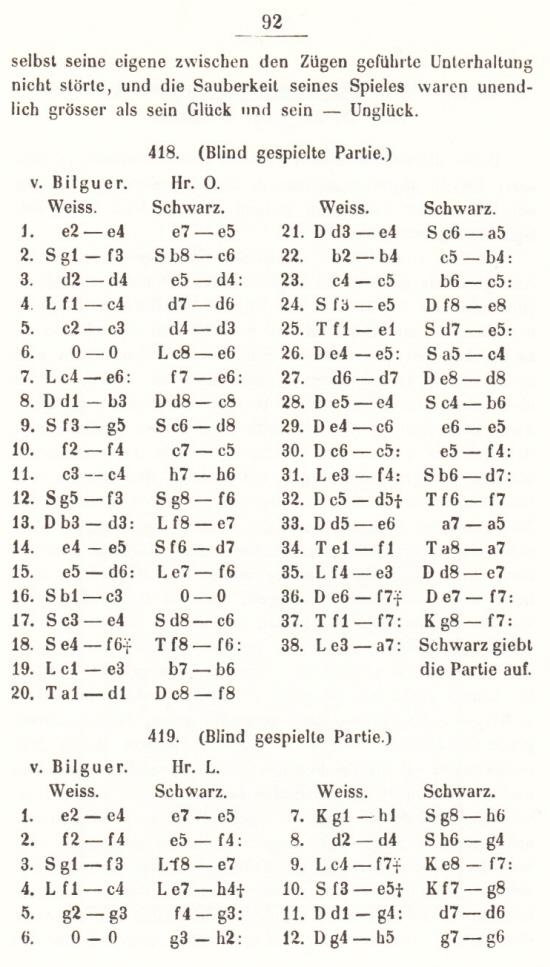
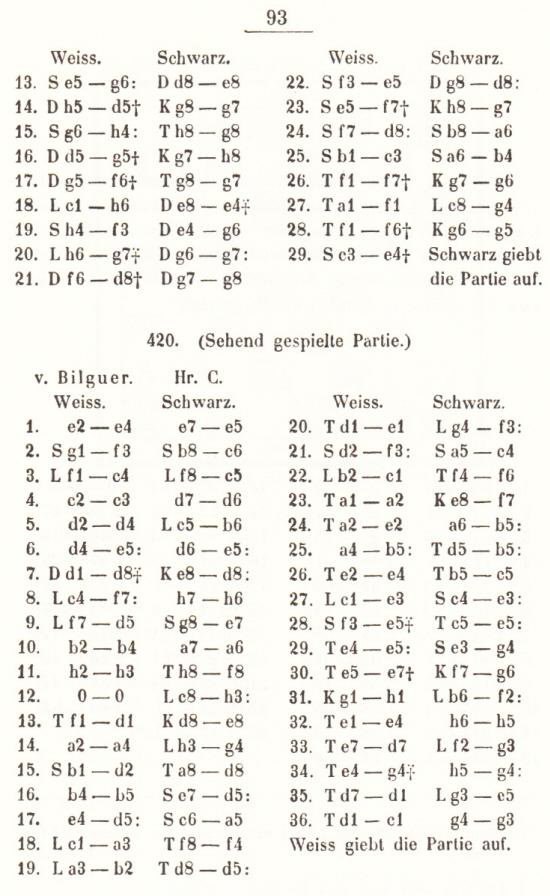
Our correspondent points out that further details about the occasion, as well as the identity of the third opponent (Crelinger), were supplied on pages 628-629 of Der bayrische Volksfreund, 1840:
‘Berlin, 20 März. (Etwas für Schachspieler) Gestern waren wir Zeuge einer in ihrer Art außerordentlichen Begebenheit. Ein Offizier, Hr. v. Bilguer, hatte vor einigen Tagen die merkwürdige Aufgabe gelöst, eine Partie Schach gegen die anwesenden sämmtlichen Schachspieler, und zwar dem Schachbrett den Rücken zuwendend, zu spielen. Er gewann die Parthie in der 7. Viertelstunde. Gestern spielte er mit drei Herren auf drei verschiedenen Brettern zugleich, und zwar so, daß seine beiden Hauptgegner im Nebenzimmer, aber bei offenen Thüren am Schachbrett saßen und zogen, während ein unpartheiischer Herr in der Mitte stand und Zug für Zug angab; sodann zog der Gegner mit dem Hrn. v. B. die dritte. In anderthalb Stunden ergab sich die Partie II, in zwei Stunden war die Partie I matt; aber bald darauf verlor Hr. v. B. die Parthie, die er eigenhändig spielte, an seinen Gegner, Hrn. Crelinger. Aber welch ein außerordentliches Gedächtnis gehört dazu, jeden Zug auf zwei unsichtbaren Schachbrettern mit allen Stellungen zu behalten, und die dritte Parthie, die zu gewinnen er sehr nahe war, auch noch zu dirigiren.’
The three games were lightly annotated (with Crelinger unidentified) on pages 45-48 of Paul Rudolf v. Bilguer by O. Koch (Leipzig, 1915). For two other games from that book see C.N. 1619 and pages 74-76 of Chess Explorations.
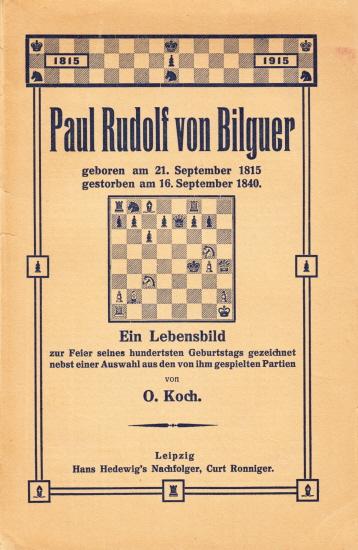
(7896)
G. Wiel
C.N. 2428 quoted from page 373 of the 1846 Chess Player’s Chronicle a description of the mysteriously unfamiliar G. Wiel as ‘a German amateur, long celebrated for his remarkable facility of playing without seeing the chessboard’. From the same source we gave one of Wiel’s games and asked for further information about him. (See page 354 of A Chess Omnibus.) No biographical details have yet been found, but here is another game:
G. Wiel (blindfold) – James Washington Hannah
Occasion?
King’s Pawn Opening
1 e4 e5 2 Nf3 Nc6 3 Bc4 Bb4 4 c3 Ba5 5 O-O f5 6 d4 exd4 7 Ng5 Ne5 8 Bxg8 h6 9 Qxd4 hxg5 10 Qxe5+ Qe7 11 Bf7+ Kxf7 12 Qxf5+ Ke8 13 Qxa5 Qd6 14 f4 b5 15 Qb4 c5 16 Qb3 Qh6 17 h3 g4 18 f5 Qb6 19 Qd5 c4+ 20 Kh2 Qc7+ 21 Bf4 Qb7 22 Qe5+ Kf7 23 f6 d6

24 fxg7 (‘It requires no ordinary powers of memory and abstraction to see the way clearly through the variations from this point without the aid of men and board.’) 24…Rxh3+ 25 gxh3 dxe5 26 Bxe5+ Bf5 27 Rxf5+ Kg8 28 Nd2 Re8 29 Bd4 Qc7+ 30 Kg2 gxh3+ 31 Kxh3 Qd6 32 Raf1 Qh6+ 33 Kg3 Qg6+ 34 Kh4 Qh7+ 35 Kg5 Qxf5+ 36 Rxf5 and wins. (‘The latter part of this game is conducted with remarkable ability by the blindfold player.’)
Source: the Chess Player’s Chronicle, 13 February 1847, page 51.
That same year the Chronicle gave several games from a match in Brighton in which H.A. Kennedy defeated G. Wiel, the latter being described on page 107 of the 3 April 1847 issue as ‘a German Amateur, long known in this country as a player of considerable skill’.
Staunton published a number of his own wins (giving the odds of the queen’s knight) against ‘a skilful German Amateur’ (to quote the phrase used on page 405 of the 1842 Chess Player’s Chronicle – see also pages 35, 36, 116 and 117 from the 1843 issues). His opponent was never named, but when one of the games appeared on page 31 of Staunton’s book The Chess Player’s Companion (London, 1849), the loser was identified as ‘Mr Wiel, a German Amateur’.
So far we have found nothing about Wiel in German sources.
(3305)
For other references to this player, see the Factfinder.
William Winter
C.N. 1197 gave a selection of quotes from William Winter’s posthumous memoirs, which were published in CHESS between 29 October 1962 and 28 March 1963. They included the following:
‘Blindfold play I have never attempted seriously. I once played six, but spent so many sleepless nights trying to drive the positions out of my head that I gave it up.’ (page 110)
See also our feature article William Winter.
Johannes Hermann Zukertort
The Brooklyn Chess Chronicle (15 January 1886, page 56) had this win by Zukertort against an unnamed opponent: 1 e4 e5 2 Nc3 Nf6 3 f4 d6 4 Nf3 Nc6 5 Bc4 Bg4 6 O-O Be7 7 d3 Nh5 8 fxe5 Nxe5 9 Nxe5 Bxd1 10 Bxf7+ Kf8 11 Bxh5+ Bf6 12 Rxf6+ gxf6 13 Bh6+ Ke7 14 Nd5+ Ke6 15 Bf7+ Kxe5

16 c3 Resigns.
The occasion is said to have been an 11-board blindfold simultaneous display in Ottawa in 1884. Moves 8-16 were given on page 90 of the November 1885 Chess Monthly (which was co-edited by Hoffer and Zukertort) as being from ‘a game played simultaneously blindfold with 11 others in January 1884, at Ottawa, at the meeting of the Canadian Chess Association’. Even so, many other sources (e.g. page 188 of Chernev’s 1000 Best Short Games of Chess) give the occasion as ‘Leipzig, 1877’. Can anyone iron out the discrepancy?
(2612)
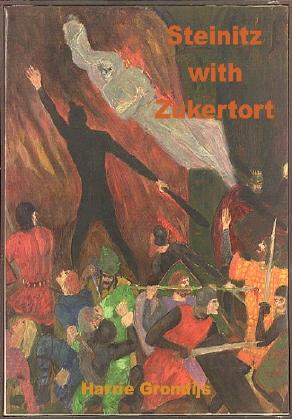
From Harrie Grondijs (Rijswijk, the Netherlands):
‘For my book Steinitz with Zukertort (Rijswijk, 2006) I tried to retrace Zukertort’s travels and games in the United States in 1883-84. As shown on pages 97 and 239, next to nothing is known about his chess activities in Washington. I have, however, now found on page 188 of the Irish Sportsman, 22 March 1884 a game which he played in a three-board blindfold display at the Washington Chess Club.’
Johannes Hermann Zukertort (blindfold) – Jacob Frech
Washington, 21 December 1883
Evans Gambit Accepted
1 e4 e5 2 Nf3 Nc6 3 Bc4 Bc5 4 b4 Bxb4 5 c3 Be7 6 d4 d6 7 Qb3 Be6 8 Bxe6 fxe6 9 Qxe6 Qd7 10 Qb3 b6 11 O-O Na5 12 Qc2 Bf6 13 Rd1 Nc6 14 Na3 Nge7 15 Nc4 Ng6 16 dxe5 Ngxe5 17 Nfxe5 Nxe5 18 Nxe5 Bxe5 19 f4 Bf6 20 e5 Be7 21 Qb3 O-O-O
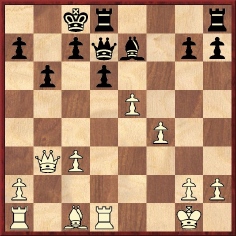
22 a4 Qc6 23 Ba3 Rhe8 24 a5 dxe5 25 Bxe7 Rxd1+ 26 Rxd1 Rxe7 27 fxe5 Qc5+ 28 Kh1 Qxe5 29 h3 Qxa5 30 Qg8+ Kb7 31 Qxh7 Qxc3 32 Qf5 Re1+ 33 Rxe1 Qxe1+ 34 Kh2 Qe7 35 Qc2 a5 36 Qc4 c6 37 h4 b5 38 Qd4 a4 39 Kh3 a3 40 g4 a2 41 h5 Qa3+ 42 White resigns.
(4720)
On page 16 of Comparative Chess (Philadelphia, 1932) Frank Marshall referred to Zukertort as ‘a former champion of the world’ (see page 297 of A Chess Omnibus).
Russell Miller (Vancouver, WA, USA) draws attention to this passage on page 5 of the Sedalia Weekly Bazoo of 5 February 1884:
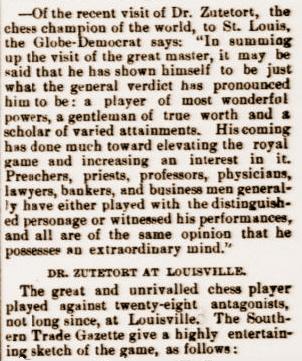
We note that the text quoted from the Southern Trade Gazette, which also referred to a 12-board blindfold exhibition by Zukertort in Louisville on 26 December 1883, ended as follows:
‘When Mr Lovenhart opened 1 P-KKt4 the doctor waited a full minute before he made his reply. A bystander suggested that Zukertort was not thinking of the game but merely trying to form a mental image of the man who would open a game in that manner.’
(7112)
Hans Renette (Bierbeek, Belgium) has discovered this illustration on page 376 of Pictorial World, 22 October 1885:
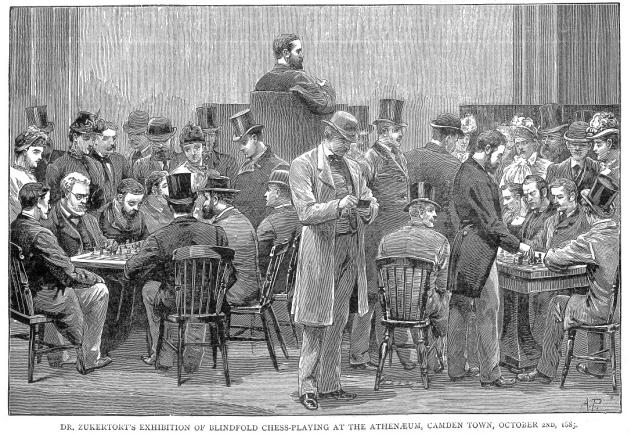
As reported on pages 186-192 of the 28 October 1885 Chess Player’s Chronicle, page 66 of the November 1885 Chess Monthly and page 396 of the November 1885 BCM, Zukertort won four of the eight games, the others being left unfinished.
Although the above caption gave the date of the display as 2 October, all three periodicals specified that it took place the following day. The Chronicle gave all eight game-scores, and below are Zukertort’s victories:
Johannes Hermann Zukertort – G.L. Brooks
London, 3 October 1885
Vienna Gambit
1 e4 e5 2 Nc3 Nc6 3 f4 exf4 4 Nf3 g5 5 h4 g4 6 Ng5 Ne5 7 d4 h6 8 Bxf4 Ng6 9 Nxf7 Kxf7 10 Bc4+ d5 11 Nxd5 Kg7 12 Bxc7 Qe8 13 O-O Be6 14 h5 N8e7 15 hxg6 Nxg6 16 Nf6 Qe7 17 Nh5+ Kh7 18 Bxe6 Qxe6
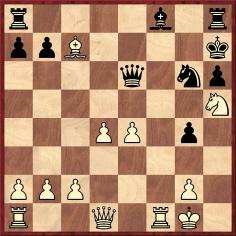
19 Qxg4 Qxg4 20 Nf6+ Kg7 21 Nxg4 Be7 22 Ne5 Bf6
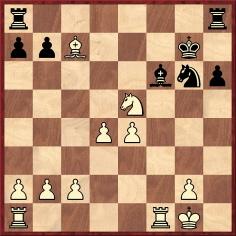
23 Rxf6 Kxf6 24 Rf1+ Kg7 25 d5 Rac8 26 Nxg6 Kxg6 27 d6 Rh7. The Chronicle now gave ‘28 B to R4 Resigns’.
Johannes Hermann Zukertort – Schlesinger
London, 3 October 1885
King’s Gambit Declined
1 e4 e5 2 f4 Nc6 3 Nf3 Bc5 4 fxe5 d5 5 exd5 Qxd5 6 Nc3 Qd8 7 Bb5 Bd7 8 d4 Bb6 9 Be3 Nce7 10 Bc4 Be6 11 Qe2 Nd5 12 Bg5 Nge7 13 Nxd5 Bxd5 14 Bxd5 Qxd5 15 c4 Qe6 16 c5 Ba5+ 17 Kf2 c6 18 a3 Nd5 19 b4 Bd8 20 Rhf1 Bxg5 21 Nxg5 Qf5+ 22 Nf3 Nf4 23 Qd2 Rd8 24 Kg1 g5
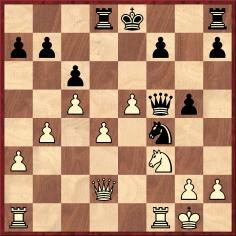
25 Nxg5 Rxd4 26 Qxd4 Ne2+ 27 Kh1 Qxf1+ 28 Rxf1 Nxd4 29 Nxf7 Rf8 30 Nd6+ Ke7 31 Rxf8 Kxf8 32 Nxb7 Nc2 33 Na5 Nd4 34 a4 a6 35 Nc4 Ke7 36 Kg1 Ke6 37 Kf2 Kd5 38 Nb6+ Kxe5 39 Nd7+ Kd5 40 Nb8 a5 41 bxa5 Kxc5 42 Kg3 Kd6
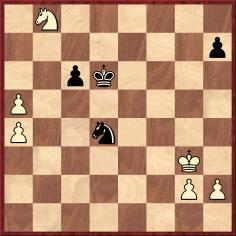
43 Nxc6 Nxc6 and White won.
Johannes Hermann Zukertort – Smith
London, 3 October 1885
Queen’s Pawn Game
1 d4 d5 2 Nf3 f6 3 c4 e6 4 e3 Bb4+ 5 Nc3 Ne7 6 Bd3 O-O 7 O-O Bxc3 8 bxc3 f5 9 Ba3 Rf6 10 Qb3 c6 11 Rad1 Ng6 12 Rfe1 a5 13 cxd5 exd5 14 c4 a4 15 Qc2 Be6 16 Ng5 Bd7 17 cxd5 cxd5
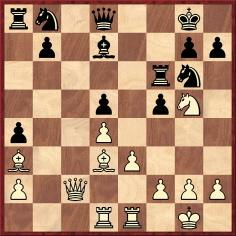
18 e4 fxe4 19 Bxe4 Bc6 20 Bxg6 Rxg6 21 Be7 Qd7 22 Rd3 h5 23 Rf3 Qxe7 24 Rxe7 Rxg5 25 Rg3 Rxg3 26 hxg3 Resigns.
Johannes Hermann Zukertort – Kimmell
London, 3 October 1885
Evans Gambit Accepted
1 e4 e5 2 Nf3 Nc6 3 Bc4 Bc5 4 b4 Bxb4 5 c3 Bc5 6 O-O d6 7 d4 exd4 8 cxd4 Bb6 9 Nc3 Nce7 10 Qb3 Be6 11 Bxe6 fxe6 12 Ng5 Nc6 13 Nxe6 Qd7 14 d5 Na5 15 Qc2 a6 16 Bb2 Nc4 17 Na4 Nxb2 18 Nxb6 cxb6 19 Qxb2 Nf6 20 Qxb6 Kf7 21 Rac1 Rac8 22 f3 h6 23 Rb1 Rb8 24 Rfc1 Rhc8 25 Rxc8 Rxc8
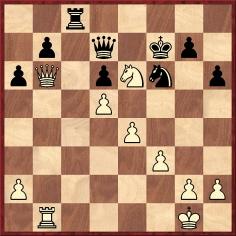
26 Qxb7 Rc1+ 27 Rxc1 Qxb7 28 Nd8+ Ke7 29 Nxb7 Resigns.
(8514)
From page 8 of the St Louis Daily Globe-Democrat, 29 December 1883:
‘Dr J.H. Zukertort, the champion chessplayer of the world, and proprietor and editor of the Chess Monthly, published at Liverpool [sic], Eng., arrived in the city yesterday from Louisville on his trip around the world ...
In conversation with the champion a Globe-Democrat reporter elicited the following interesting facts concerning his life as a chessplayer, his opinion of American chessplayers and his faculty of playing blindfolded. ...
“How is it, Doctor”, said the reporter, “that you became so proficient in blindfold playing, and what is your best record at such style of game?”
“My proficiency in this direction I ascribe to the reading of chess books. In reading them so much I discovered my ability to carry on a game as I read it, without even looking at a board. This ability or faculty I cultivated, and finding that I could play one game, I tried two, which was done successfully, keeping it up until in January 1868 I gave a public exhibition, my first one, in which I played seven games and afterwards nine at one time. I kept on gradually improving, until now I have the record of having played 16 blindfold games, the greatest number of simultaneous blindfold games ever played by any chessplayer. These games were played in the West End Chess Club, of London, 11 [sic – 16] December 1876, against 16 of the strongest amateur players of the St George’s and West End Clubs. I lost one, drew three and won 12.”’
(9864)
Jan Kalendovský (Brno, Czech Republic) provides the following illustration:
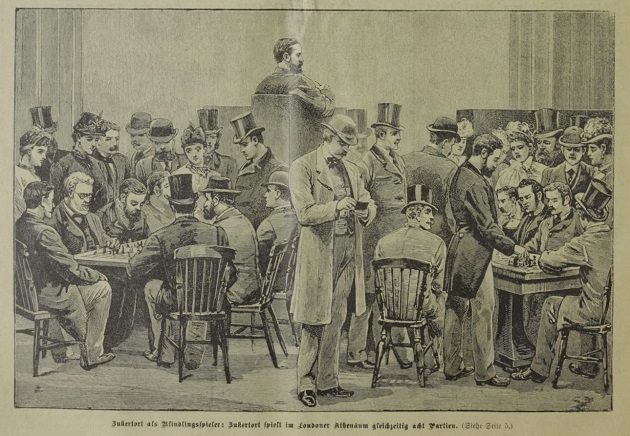
Source: Das interessante Blatt, 5 November 1885, page 6. This picture of Zukertort is a much better version of the one shown in C.N. 8514.
(10760)
From pages 182-183 of the Chess Player’s Chronicle, 1 August 1879:

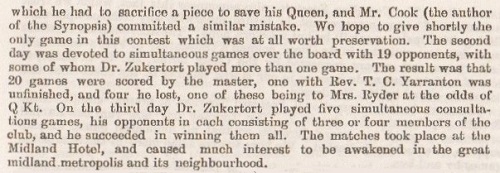
Regarding the reference, in connection with Zukertort’s 12-board blindfold display in Birmingham on 26 June 1879, to ‘the only game in this contest which was at all worth preservation’, pages 227-228 of the 1 October 1879 Chronicle gave the win by Zukertort over John Halford:
1 e4 e6 2 d4 b6 3 Bd3 Bb7 4 Nh3 Nf6 5 f3 c5 6 c3 Nc6 7 Be3 Rc8 8 O-O cxd4 9 cxd4 Be7 10 Nc3 Nb4 11 Be2 h6 12 a3 Nc6 13 Rc1 d5 14 e5 Nh7 15 f4 g6 16 Rc2 Nf8 17 Bd3 Na5 18 Nf2 Nc4 19 Bc1 a6 20 Qe2 b5 21 a4 Qb6 22 axb5 axb5 23 b3 Na5 24 Nxb5 Rxc2 25 Qxc2 Nc6 26 Be3 Kd7
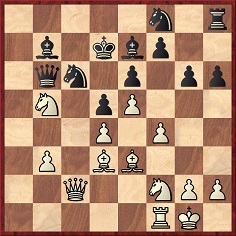
27 Rc1 Ba6 28 Qe2 Nb4 29 Nc7 Nxd3 30 Nxd3 Bxd3 31 Qxd3 Nh7 32 Na6 Ra8 33 Nc5+ Kd8 34 Qc2 h5 35 b4 Qc6 36 Qd3 Qb6 37 b5 Nf8 38 Na6 Rc8 39 Rxc8+ Kxc8 40 Bd2 Nd7 41 h3 Kb7 42 Bb4 Bxb4 43 Nxb4 Nb8 44 Nc2 Qa5 45 Kf2 Qa2 46 Qc3 Qb1 47 Qc5 Qb2 48 Kf3 Qb3+ 49 Ne3 Qd3 50 Qe7+ Kb6 51 Qxf7 Qe4+ 52 Ke2 Kxb5 53 Qxe6 Nc6 54 Qxd5+ ‘and wins’.
A second score, in which White was identified as ‘Master Frank Brown’, was published in The Field, 25 October 1879. Steinitz commented:
‘The game is also remarkable on account of the youth of the performer’s adversary on this occasion, who, we understand, is only 16 years of age.’
1 e4 e5 2 Nf3 Nc6 3 Bc4 Bc5 4 O-O Nf6 5 d3 d6 6 h3 h6 7 Nc3 g5 8 Nh2 g4 9 hxg4 Rg8 10 Be3 Nxg4 11 Qf3 Rg7 12 Nd5 Nxh2
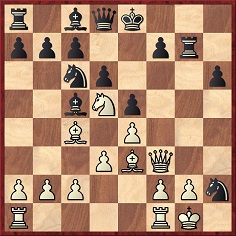
13 Nf6+ Kf8 14 Kxh2 Nd4 15 Bxd4 Bxd4 16 c3 Bb6 17 Rh1 Bg4 18 Nxg4 Qh4+ 19 Kg1 Qxg4 20 Qxg4 Rxg4 21 Rxh6 Ke7 22 Kf1 Rag8 23 g3 R8g7 24 Ke2 R4g5 25 Rah1 f5 26 Rh7 fxe4 27 Rxg7+ Rxg7 Drawn.
Steinitz’s final note on the Brown v Zukertort encounter:
‘The game was here given up as drawn, owing to lateness of the hour. White has still kept his pawn ahead, but he had hardly any fair prospect of winning; not alone on account of his opponent’s strength, which is scarcely diminished in his blindfold trials, but also by the nature of the position, more especially as the bishops of the two parties are of opposite colour.’
In his Field column on 5 July 1879 Steinitz reported that six of Zukertort’s games in the blindfold display were resumed the following day (27 June), but below is the account on page 8 of the Birmingham Daily Post, 27 June 1879:
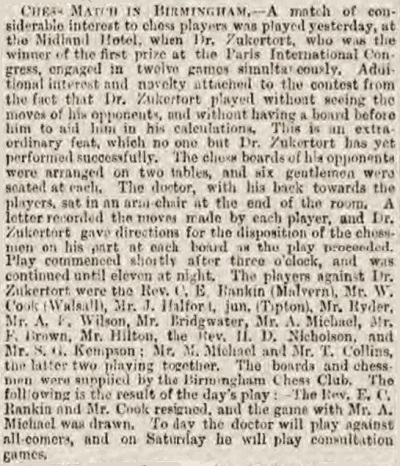
(9795)
See also our feature article on Zukertort.
From page 61 of Chernev’s Wonders and Curiosities of Chess:
‘In 1874, a tournament was conducted in Prague in which all the competitors played their games blindfold. The winner was the problemist Jan Dobruský, who scored a magnificent 13½ out of 14.’
We should welcome further information on this event.
(1560)
Chernev wrote similarly in a ‘Curious Chess Facts’ article on page 4 of the February 1933 Chess Review.
Ken Whyld (Caistor, England) reports that details of the Prague blindfold tournament were published on pages 39-40 of the February 1875 issue of Österreichische Schachzeitung, together with the crosstable. A game was given in that issue, and a further two in March, but the quality was not good.
(1616)
Owen Hindle (Cromer, England) submits this blindfold correspondence game:
Norris – Arthur Towle Marriott
Correspondence game
Ruy López
1 e4 e5 2 Nf3 Nc6 3 Bb5 a6 4 Ba4 f5 5 d4 exd4 6 O-O Bc5 7 Ng5 Nf6 8 Bb3 d5 9 exd5 Na5 10 Re1+ Kf8 11 d6 Nxb3 12 dxc7 Qxc7 13 cxb3 Bd7 14 b4 h6 15 Ne6+ Bxe6 16 bxc5 Kf7 17 Qxd4 Rad8 18 Qb4 g5 19 Nc3 f4 20 f3 Rhe8 21 Na4 a5 22 Qc3 Kg6 23 Nb6 g4 24 Qxa5 gxf3 25 gxf3 Kh7 26 Nc4 Qg7+ 27 Kf2 Bh3 28 Rg1
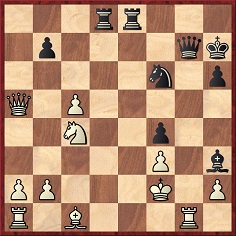
Black announced mate in four moves.
Source: The Westminster Papers, 1 February 1879, pages 221-222.
The Papers introduced the game as follows: ‘Played, by correspondence, between Mr Norris, of London, and Mr A. Marriott, of Nottingham, the latter playing blindfold.’
(Kingpin, 1997)
Regarding the nineteenth-century player Miss Stella, see C.N. 3145 in Memory Feats of Chess Masters.
Russell Miller (Chelan, WA, USA) quotes the following passage about the engineer and inventor James Buchanan Eads (1820-87) from page 23 of Rising Tide: The Great Mississippi Flood of 1927 and How it Changed America by John M. Barry (New York, 1997):
‘He had the passion of the lonely, an intense focus on the few things he cared about. He taught himself chess, became one of the city’s [St Louis, MO] best players and engaged in simultaneous games allowing his opponents a board but playing himself without one. There was something lonely about chess as well, and brutal, and he gave no quarter.’
What more is known about Eads’ interest in chess?
(3930)
Neil Brennen (Spring City, PA, USA) writes:
‘David McCullough’s 1972 book The Great Bridge has the following comment on Eads’ chessplaying, on page 181:
“In early 1870 Eads was approaching 50. He was the sort of person who liked to play chess with two or three others at a time ...”
McCullough gives no specific source for this information, but instead says he took “the general biographical background” from the Dictionary of American Biography and three other books: Florence L. Dorsey’s Road to the Sea (1947), Joseph Gies’ Bridges and Men (1963) and C.M. Woodward’s A History of the St. Louis Bridge (1881).
The same book includes, on page 156, a comment that Washington Roebling, while in Pittsburgh in 1858 overseeing the construction of a bridge, “played chess with the other boarders” at his boarding house. McCullough took this from a 2 May 1858 letter from Roebling to Charles Swan.’
(3935)
How many players have been given, or have given themselves, the title ‘blindfold world champion’? Below are two cases which we have noted recently:
1. Opposite page 74 of the London Chess Fortnightly, 14 January 1893 was a photograph of ‘J.H. Blackburne, Blindfold Champion of the World’.
2. Page 241 of CHESS, July 1946 had an article entitled ‘My Sixth US Tour’ by George Koltanowski (‘World’s blindfold chess champion’).
(4396)
Addition on 6 September 2024:
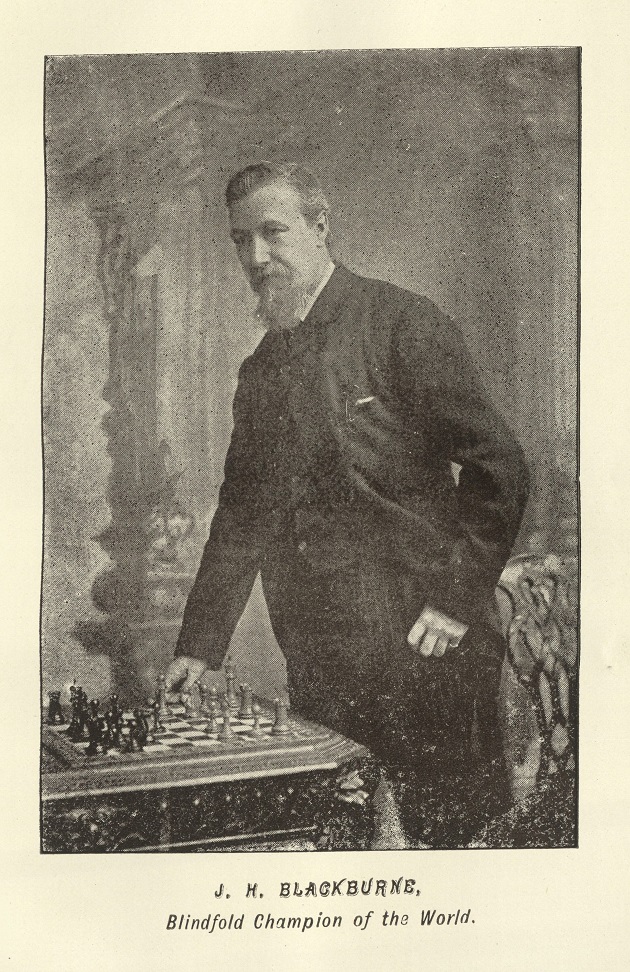
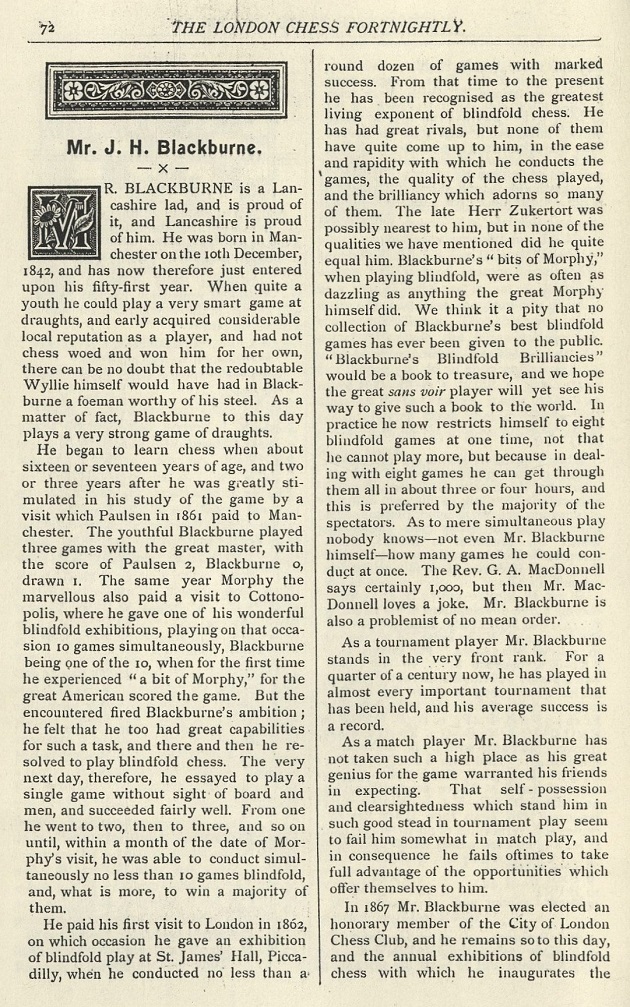

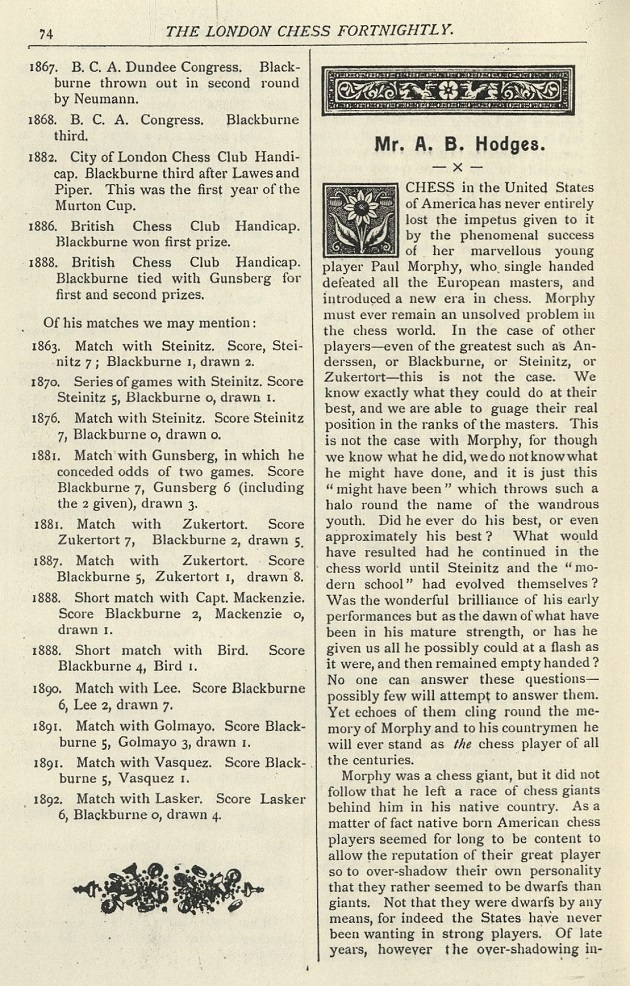
The above scans have been provided by the Cleveland Public Library.
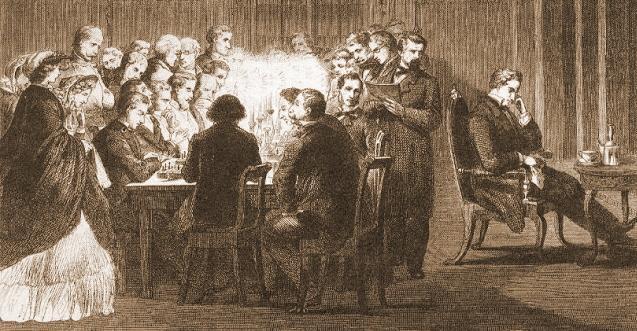
Louis Paulsen
‘The whole subject is chaotic’ was our comment in C.N. 898 regarding attempts to establish a list of the progressive records for the number of blindfold games played simultaneously. Nearly a quarter of a century on, the chaos has been removed, thanks to Blindfold Chess by Eliot Hearst and John Knott (Jefferson, 2009). Appendix A (pages 395-406) is entitled ‘“World Record” Blindfold Simultaneous Exhibitions Since 1782’, and we summarize here the sequence of record-breaking displays in terms of number of boards:
1782, London: F.A.D. Philidor (2)
1783, London: F.A.D. Philidor (3)
1851, Paris: L. Kieseritzky (4)
1857, New York: L. Paulsen (5)
1858, Dubuque: L. Paulsen (7)
1858, Dubuque: L. Paulsen (8)
1858, Chicago: L. Paulsen (10)
1858, St Louis: L. Paulsen (12)
1859, Dubuque: L. Paulsen (15)
1876, London: J.H. Zukertort (16)
1900, New Orleans: H.N. Pillsbury (17)
1900, Philadelphia: H.N. Pillsbury (20)
1902, Hanover: H.N. Pillsbury (21)
1902, Moscow: H.N. Pillsbury (22)
1904, Moscow: V. Ostrogsky (23)
1919, Haarlem: R. Réti (24)
1921, Kaschau: G. Breyer (25)
1924, New York: A. Alekhine (26)
1925, Paris: A. Alekhine (28)
1925, São Paulo: R. Réti (29)
1931, Antwerp: G. Koltanowski (30)
1933, Chicago: A. Alekhine (32)
1937, Edinburgh: G. Koltanowski (34)
1943, Rosario: M. Najdorf (40)
1947, São Paulo: M. Najdorf (45).
Blindfold Chess includes the available particulars in each case, and the first section (pages 207-312) of Part III presents all the game-scores traced from these exhibitions – about 300 games in all.
The above list omits the display by János Flesch (supposedly 52 boards in Budapest in 1960) for the reasons discussed on pages 99-110. The last two pages of that section have a report entitled ‘A Sensational Postscript: Flesch vs Barcza!?’ which relates that four Hungarian contacts independently told the co-authors that a year or two after Flesch’s exhibition Gedeon Barcza described Flesch as a ‘crook’ and a ‘fraud’ and was then sued by Flesch for defamation of character. Whether any such case went to trial has yet to be established. Can it be hoped that a researcher in Hungary will look into the matter?
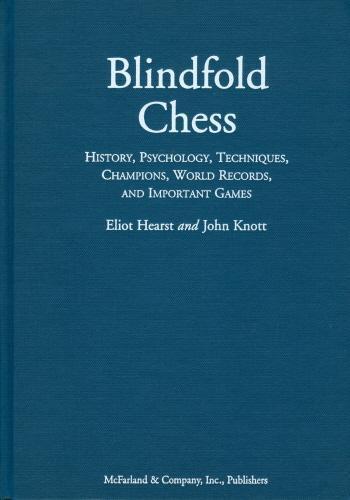
(5941)
From R.J. Buckley’s chess column in the Birmingham Weekly Mercury, 25 August 1906, page 3:
‘What has the sensational exhibition to do with beautiful chess?
Why this craving for the red fire, the jugglery, the purposeless mental acrobatism that was fatal to Pillsbury? The desire for such exhibitions denotes a low level of intelligence.
Why should civilized chess amateurs exhibit the tastes of the bricklayer’s hodman or the British farm labourer?
Let the blindfold business die with poor Pillsbury. If another great chess master should arise in America, let him not be “butchered to make a gobe-mouche holiday”.’
(6170)
Eliot Hearst writes:
‘What is the record for the number of simultaneous blindfold games played by a woman? In all the research for our book Blindfold Chess John Knott and I never came across any report of a scheduled, well-regulated blindfold simultaneous display by a woman.’
(6289)
Information on blindfold displays by women is still being sought. In the meantime, Jerry Spinrad (Nashville, TN, USA) has provided this report concerning Mrs J.W. Gilbert on page 1 of the Hartford Weekly Times, 4 November 1871:
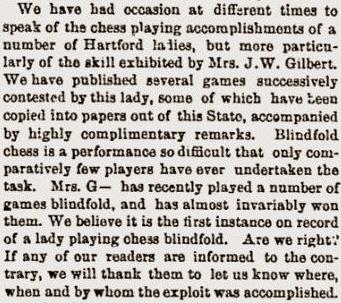
(6468)
Jerry Spinrad mentions that a number of newspapers in November 1858 carried reports, courtesy of Harper’s Weekly, on two young players of blindfold chess in Fayette County, KY. For example, the following appeared on page 2 of the Lancaster Intelligencer of 16 November 1858:

This and other newspaper reports can be consulted at the Penn State Digital Library.
(6296)
From page 477 of the December 1913 BCM:
‘On 16 October, at the Colchester Chess Club, Mr A.C. Robst gave an interesting blindfold performance of the knight’s tour. He first gave the tour with a single knight from any square, then with two knights, and finally with four knights simultaneously. This last is a feat which has not to our knowledge been previously attempted blindfold. The board was not numbered, Mr Robst named the squares in the English notation.’
(7169)
From page 63 of the London Chess Fortnightly, 14 December 1892:
‘Mr C. Moriau (City champion) gave a wonderful blindfold performance at the Metropolitan Chess Club on 5 December. He was opposed by six opponents, and the games were conducted two in English, two in French, and two in German. Mr Moriau, in the end, scored four wins against two losses. When it is borne in mind that Mr Moriau had to conduct the mental operations of these six games in three distinct notations, the whole performance must be pronounced a wonderful mental feat.’
(7623)
From page 150 of the Chess Player’s Chronicle, 12 June 1895:

The match between Curnock and Lawrence, duly played on 15 June 1895, was discussed on pages 161-162 of the 19 June 1895 issue, with all six game-scores given on pages 167-169 from Gunsberg’s Daily News column. Lawrence won games two and six, each in 15 moves but the latter after adjudication. Game one was left unfinished after 17 moves, and games three, four and five were also adjudicated as drawn, each after 15 moves. Lawrence’s win in game two:
1 e4 e5 2 f4 Bc5 3 Nc3 d6 4 Nf3 Nf6 5 d3 Ng4 6 d4 exd4 7 h3 dxc3 8 hxg4 Bxg4 9 Bc4 c6 10 Qd3 Bxf3 11 Qxf3 Qb6 12 b3 Nd7
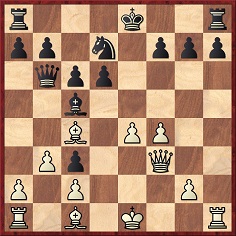
13 Ke2 O-O-O 14 Be3 d5 15 exd5 Rhe8 16 White resigns.
(11739)
The Curnock v Lawrence match was the subject of negative comment by Louis van Vliet, as reported on page 175 of the Chess Player’s Chronicle, 26 June 1895:

From page 8 of van Vliet’s Sunday Times chess column, 16 June 1895:

(11746)
Concerning the imaginary blindfold chess expert Richard Rooke Rookewarden, see A Non-Existent Blindfold Chessplayer.
John Donaldson’s Mechanics’ Institute Chess Room Newsletter of 16 February 2018 reports the death of Eliot Hearst on 30 January 2018, at the age of 85.
Firstly here, we show three photographs of Professor Hearst from his early chess career:
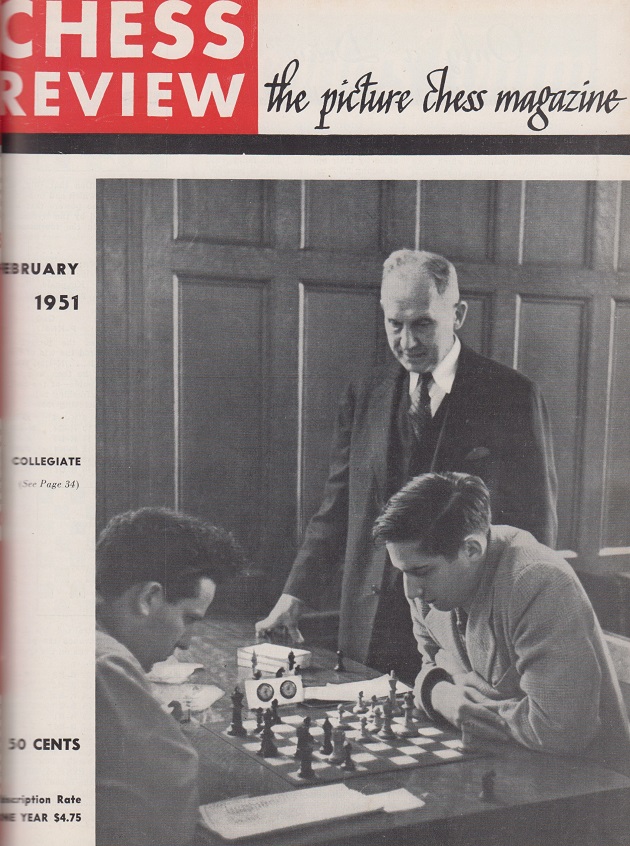
From page 34:
‘Captains Eliot Hearst of Columbia and Maurice Ginsberg (left) of Syracuse meet in the critical last round of the Intercollegiate Team Championship. Onlooker Louis J. Wolff is an old blue, captained winning Lion team when Capablanca played on it.’
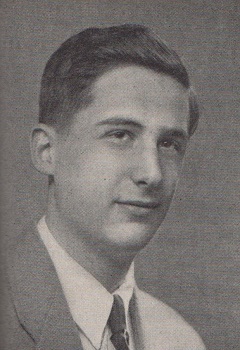
Chess Review, October 1951, page 293
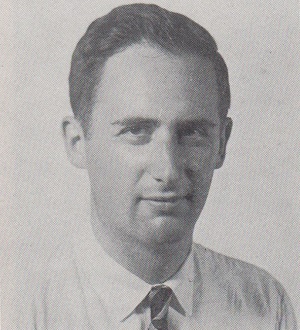
Chess Life, June 1963, page 145
In later life Eliot Hearst’s main contribution to chess was the fine book which he co-authored with John Knott, Blindfold Chess (Jefferson, 2009). The back cover of the subsequent paperback edition:
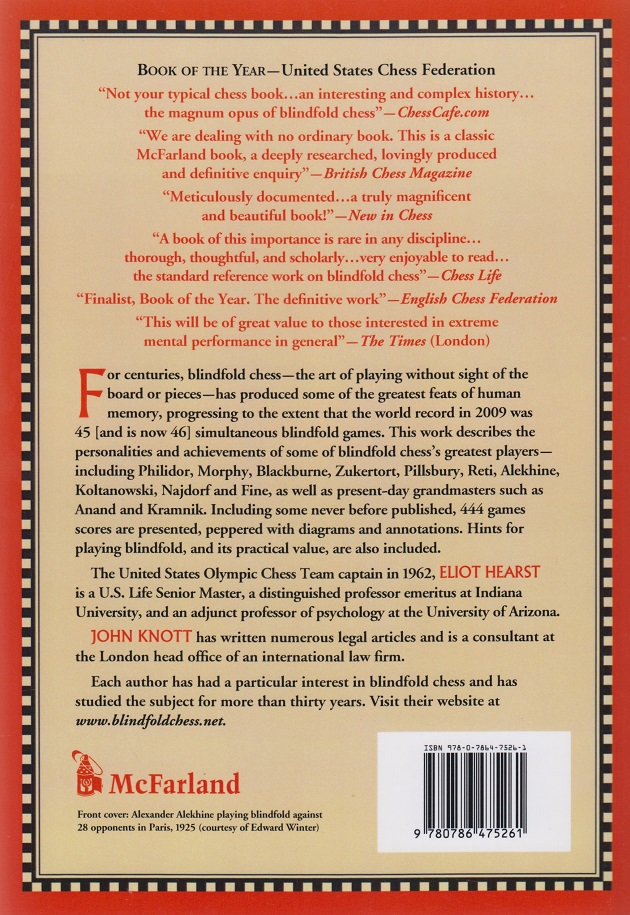
The co-authors documented updates on their Blindfold Chess website.
Professor Hearst began work on the blindfold chess project in the mid-1980s, though slowly in view of other commitments. From a letter to us dated 12 February 1986:
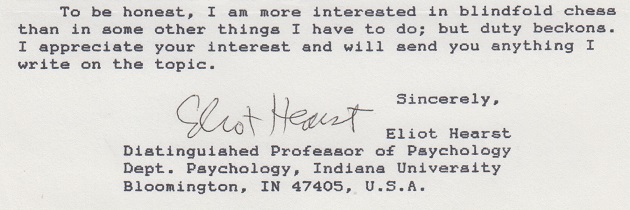
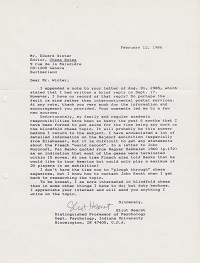
He made a number of valuable contributions to C.N., the last being in September 2017 (C.N. 10584), and his hallmarks were kindness and intellectual rigour.
Below, finally, is the front cover of a non-chess work, The First Century of Experimental Psychology (Hillsdale, 1979), of which he generously gave us an inscribed copy:
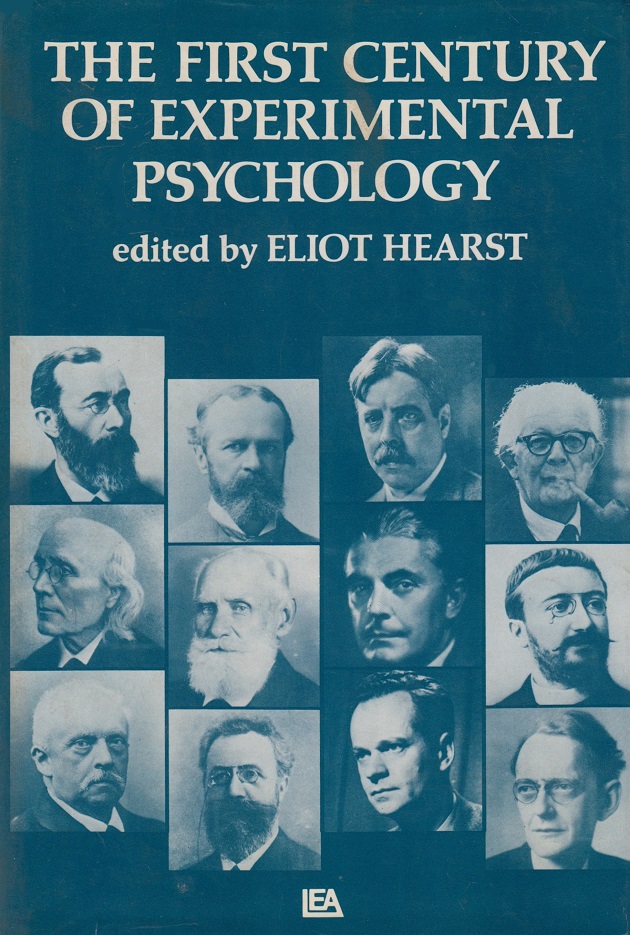
(10740)
A blindfold game won by Camille Moriau against Léon Guinet, from pages 102-103 of La Stratégie, 15 April 1893:
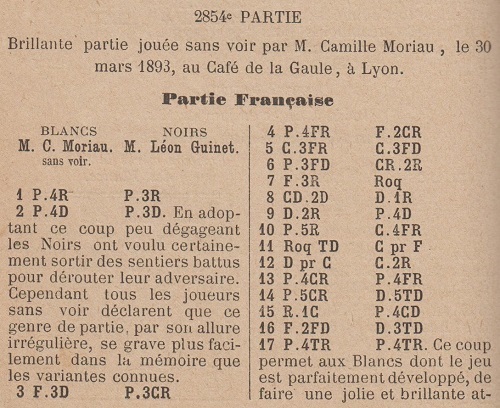
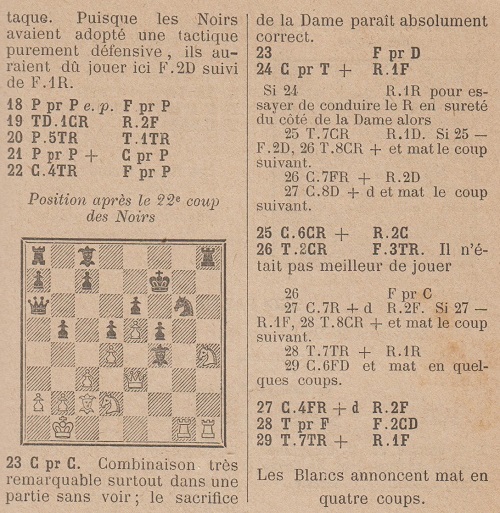
1 e4 e6 2 d4 d6 3 Bd3 g6 4 f4 Bg7 5 Nf3 Nc6 6 c3 Nge7 7 Be3 O-O 8 Nbd2 Qe8 9 Qe2 d5 10 e5 Nf5 11 O-O-O Nxe3 12 Qxe3 Ne7 13 g4 f5 14 g5 Qa4 15 Kb1 b5 16 Bc2 Qa6 17 h4 h5 18 gxh6 Bxh6 19 Rdg1 Kf7 20 h5 Rh8 21 hxg6+ Nxg6 22 Nh4 Bxf4 23 Nxg6 Bxe3 24 Nxh8+ Kf8 25 Ng6+ Kg7 26 Rg2 Bh6 27 Nf4+ Kf7 28 Rxh6 Bb7 29 Rh7+ Kf8, and White announced mate in four moves.
(10966)
A blindfold miniature by John Warcup Cornforth:
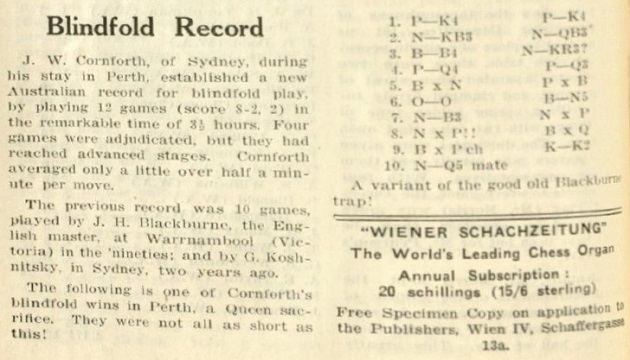
Australasian Chess Review, 27 February 1937, page 26
1 e4 e5 2 Nf3 Nc6 3 Bc4 Nh6 4 d4 d6 5 Bxh6 gxh6 6 O-O Bg4 7 Nc3 Nxd4 8 Nxe5 Bxd1 9 Bxf7+ Ke7 10 Nd5 mate.
(11160)
To the Chess Notes main page.
To the Archives for other feature articles.
Copyright: Edward Winter. All rights reserved.